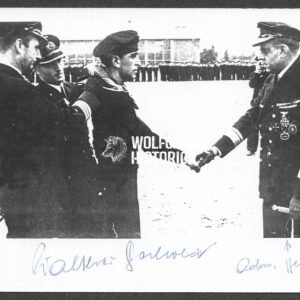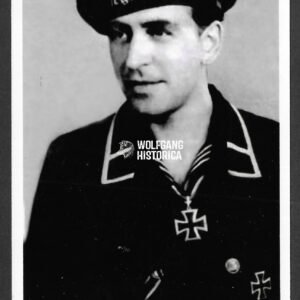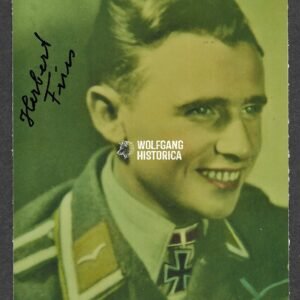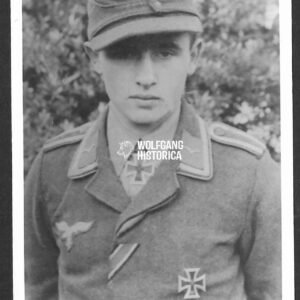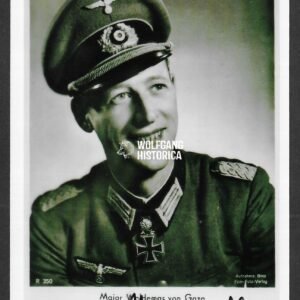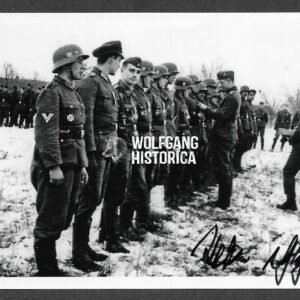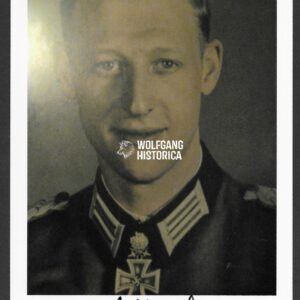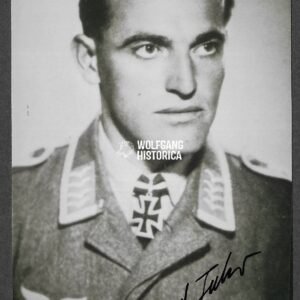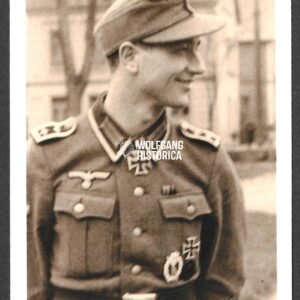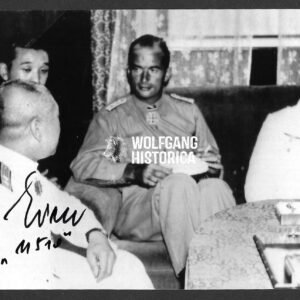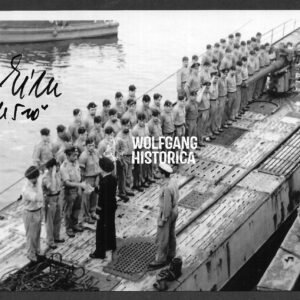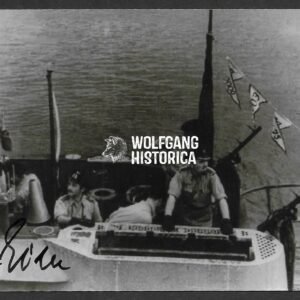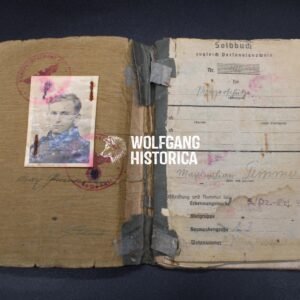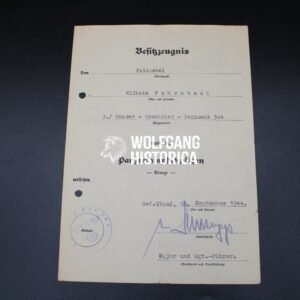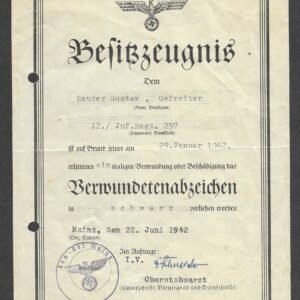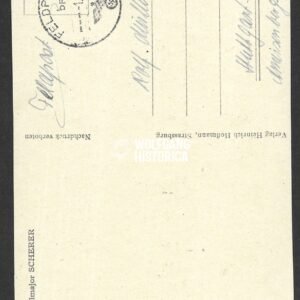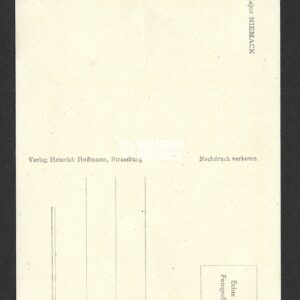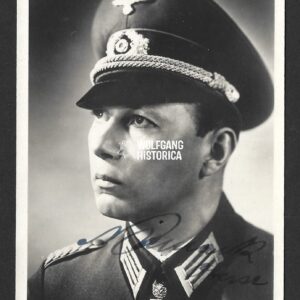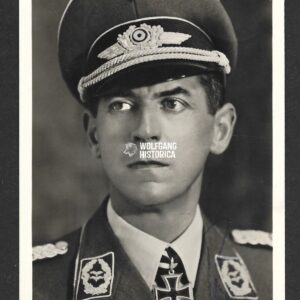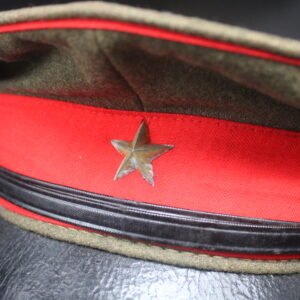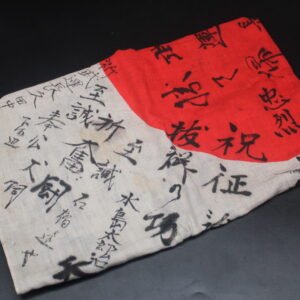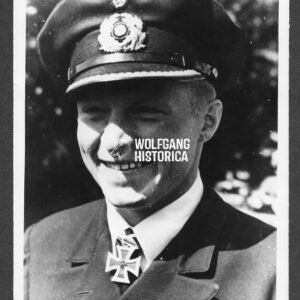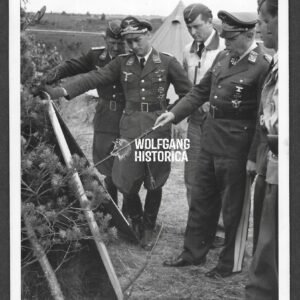Customers facing issues ordering, contact me
via info@wolfganghistorica.com or wolfganghistorica@gmail.com
NEW HOUTEN MILITARIA FAIR VIDEO ONLINE: Watch it here!
Leopold Hackl – Nachtschlachtgruppe 3
€15,00Original Postwar Signature on a Postwar Photo of Leopold Hackl
Fahnenjunker-Oberfeldwebel Leopold Hackl (29 June 1916 – 15 November 2010) served as a Luftwaffe pilot during the Second World War. He distinguished himself as a Flugzeugführer with Nachtschlachtgruppe 3, a night ground-attack unit, where he earned the Knight’s Cross of the Iron Cross in the closing months of the war.
Awards and Decorations
-
Iron Cross 2nd Class (Eisernes Kreuz II. Klasse)
-
Iron Cross 1st Class (Eisernes Kreuz I. Klasse)
-
Front Flying Clasp of the Luftwaffe in Bronze & Silver
-
Knight’s Cross of the Iron Cross (Ritterkreuz des Eisernen Kreuzes) – 20 March 1945 as Oberfeldwebel und Flugzeugführer, Stab/Nachtschlachtgruppe 3
Knight’s Cross Action
Hackl received the Ritterkreuz for his outstanding bravery and skill in conducting numerous low-level night ground-attack missions against Soviet targets. His determined flying in obsolete aircraft under constant enemy fire significantly disrupted Soviet supply lines and troop concentrations during the desperate defensive battles of early 1945.
Career Highlights
-
Night Ground-Attack Specialist: Operated in close air support and harassment roles at night, flying vulnerable aircraft at low altitude against heavily defended Soviet positions.
-
Ritterkreuz Recognition: Awarded for his exceptional courage and effectiveness during the last phase of the war, when the Luftwaffe’s resources were stretched to the limit.
-
Postwar Life: Survived the war and lived until 2010, passing away at the age of 94.
Item Details
-
Type: Original postwar signed photograph
-
Size: Postcard format
-
Condition: Very good, clean autograph
Collector’s Note
Leopold Hackl stands out as one of the few Nachtschlachtgruppe pilots to be awarded the Knight’s Cross, highlighting the importance of low-level night attack units in the final defensive battles of the Eastern Front. His signature is a scarce addition to any collection focusing on Luftwaffe pilots or Ritterkreuzträger of late-war ground-attack formations.
Karl Glätzer – Grenadier-Regiment 426
€15,00Original Postwar Signature on a Postwar Photo of Karl Glätzer
Karl Glätzer (1 February 1915, Solingen/Rhineland – 13 September 2013, Cologne) was a German officer in the Heer who rose to the rank of Hauptmann during the Second World War. A highly decorated infantry officer of the 126. Infanterie-Division, he was recognized for his repeated bravery and leadership on the Eastern Front, earning the Knight’s Cross of the Iron Cross in April 1944.
Awards and Decorations
-
Knight’s Cross of the Iron Cross (Ritterkreuz des Eisernen Kreuzes) – 9 April 1944 as Hauptmann, Führer I./Grenadier-Regiment 426, 126. Infanterie-Division
Knight’s Cross Action
Glätzer received the Ritterkreuz for his outstanding leadership of I./Grenadier-Regiment 426 during heavy defensive battles on the Eastern Front. Despite repeated wounds—including five separate combat injuries by early 1944—he returned to the front and led his men with determination. His personal courage and ability to stabilize critical sectors of the front under extreme Soviet pressure were decisive in maintaining the cohesion of his division’s defensive line.
Career Highlights
-
Entered service before the war and initially served with Infanterie-Regiment 426, part of the 126. Infanterie-Division.
-
Distinguished himself as a front-line company and later battalion commander.
-
Repeatedly wounded in combat, eventually receiving the Gold Wound Badge for his fifth injury.
-
As Hauptmann and battalion leader, earned the Knight’s Cross for his command during the brutal winter and spring fighting of 1944.
-
Survived the war and lived until 2013, reaching the age of 98.
Item Details
-
Type: Original postwar signed photograph
-
Size: Postcard format
-
Condition: Very good, clear autograph
Collector’s Note
Karl Glätzer is a representative of the hard-fighting Ritterkreuzträger of the infantry, whose service reflects the resilience and sacrifice of front-line leaders of the Eastern Front. His combination of awards—especially the Knight’s Cross and the rare Gold Wound Badge—underscores both his combat effectiveness and the heavy personal toll of his service.
Karl Glätzer – Grenadier-Regiment 426
€15,00Original Postwar Signature on a Postwar Photo of Karl Glätzer
Karl Glätzer (1 February 1915, Solingen/Rhineland – 13 September 2013, Cologne) was a German officer in the Heer who rose to the rank of Hauptmann during the Second World War. A highly decorated infantry officer of the 126. Infanterie-Division, he was recognized for his repeated bravery and leadership on the Eastern Front, earning the Knight’s Cross of the Iron Cross in April 1944.
Awards and Decorations
-
Knight’s Cross of the Iron Cross (Ritterkreuz des Eisernen Kreuzes) – 9 April 1944 as Hauptmann, Führer I./Grenadier-Regiment 426, 126. Infanterie-Division
Knight’s Cross Action
Glätzer received the Ritterkreuz for his outstanding leadership of I./Grenadier-Regiment 426 during heavy defensive battles on the Eastern Front. Despite repeated wounds—including five separate combat injuries by early 1944—he returned to the front and led his men with determination. His personal courage and ability to stabilize critical sectors of the front under extreme Soviet pressure were decisive in maintaining the cohesion of his division’s defensive line.
Career Highlights
-
Entered service before the war and initially served with Infanterie-Regiment 426, part of the 126. Infanterie-Division.
-
Distinguished himself as a front-line company and later battalion commander.
-
Repeatedly wounded in combat, eventually receiving the Gold Wound Badge for his fifth injury.
-
As Hauptmann and battalion leader, earned the Knight’s Cross for his command during the brutal winter and spring fighting of 1944.
-
Survived the war and lived until 2013, reaching the age of 98.
Item Details
-
Type: Original postwar signed photograph
-
Size: Postcard format
-
Condition: Very good, clear autograph
Collector’s Note
Karl Glätzer is a representative of the hard-fighting Ritterkreuzträger of the infantry, whose service reflects the resilience and sacrifice of front-line leaders of the Eastern Front. His combination of awards—especially the Knight’s Cross and the rare Gold Wound Badge—underscores both his combat effectiveness and the heavy personal toll of his service.
Karl Glätzer – Grenadier-Regiment 426
€15,00Original Postwar Signature on a Postwar Photo of Karl Glätzer
Karl Glätzer (1 February 1915, Solingen/Rhineland – 13 September 2013, Cologne) was a German officer in the Heer who rose to the rank of Hauptmann during the Second World War. A highly decorated infantry officer of the 126. Infanterie-Division, he was recognized for his repeated bravery and leadership on the Eastern Front, earning the Knight’s Cross of the Iron Cross in April 1944.
Awards and Decorations
-
Knight’s Cross of the Iron Cross (Ritterkreuz des Eisernen Kreuzes) – 9 April 1944 as Hauptmann, Führer I./Grenadier-Regiment 426, 126. Infanterie-Division
Knight’s Cross Action
Glätzer received the Ritterkreuz for his outstanding leadership of I./Grenadier-Regiment 426 during heavy defensive battles on the Eastern Front. Despite repeated wounds—including five separate combat injuries by early 1944—he returned to the front and led his men with determination. His personal courage and ability to stabilize critical sectors of the front under extreme Soviet pressure were decisive in maintaining the cohesion of his division’s defensive line.
Career Highlights
-
Entered service before the war and initially served with Infanterie-Regiment 426, part of the 126. Infanterie-Division.
-
Distinguished himself as a front-line company and later battalion commander.
-
Repeatedly wounded in combat, eventually receiving the Gold Wound Badge for his fifth injury.
-
As Hauptmann and battalion leader, earned the Knight’s Cross for his command during the brutal winter and spring fighting of 1944.
-
Survived the war and lived until 2013, reaching the age of 98.
Item Details
-
Type: Original postwar signed photograph
-
Size: Postcard format
-
Condition: Very good, clear autograph
Collector’s Note
Karl Glätzer is a representative of the hard-fighting Ritterkreuzträger of the infantry, whose service reflects the resilience and sacrifice of front-line leaders of the Eastern Front. His combination of awards—especially the Knight’s Cross and the rare Gold Wound Badge—underscores both his combat effectiveness and the heavy personal toll of his service.
Karl Glätzer – Grenadier-Regiment 426
€15,00Original Postwar Signature on a Postwar Photo of Karl Glätzer
Karl Glätzer (1 February 1915, Solingen/Rhineland – 13 September 2013, Cologne) was a German officer in the Heer who rose to the rank of Hauptmann during the Second World War. A highly decorated infantry officer of the 126. Infanterie-Division, he was recognized for his repeated bravery and leadership on the Eastern Front, earning the Knight’s Cross of the Iron Cross in April 1944.
Awards and Decorations
-
Knight’s Cross of the Iron Cross (Ritterkreuz des Eisernen Kreuzes) – 9 April 1944 as Hauptmann, Führer I./Grenadier-Regiment 426, 126. Infanterie-Division
Knight’s Cross Action
Glätzer received the Ritterkreuz for his outstanding leadership of I./Grenadier-Regiment 426 during heavy defensive battles on the Eastern Front. Despite repeated wounds—including five separate combat injuries by early 1944—he returned to the front and led his men with determination. His personal courage and ability to stabilize critical sectors of the front under extreme Soviet pressure were decisive in maintaining the cohesion of his division’s defensive line.
Career Highlights
-
Entered service before the war and initially served with Infanterie-Regiment 426, part of the 126. Infanterie-Division.
-
Distinguished himself as a front-line company and later battalion commander.
-
Repeatedly wounded in combat, eventually receiving the Gold Wound Badge for his fifth injury.
-
As Hauptmann and battalion leader, earned the Knight’s Cross for his command during the brutal winter and spring fighting of 1944.
-
Survived the war and lived until 2013, reaching the age of 98.
Item Details
-
Type: Original postwar signed photograph
-
Size: Postcard format
-
Condition: Very good, clear autograph
Collector’s Note
Karl Glätzer is a representative of the hard-fighting Ritterkreuzträger of the infantry, whose service reflects the resilience and sacrifice of front-line leaders of the Eastern Front. His combination of awards—especially the Knight’s Cross and the rare Gold Wound Badge—underscores both his combat effectiveness and the heavy personal toll of his service.
Karl Glätzer – Grenadier-Regiment 426
€15,00Original Postwar Signature on a Postwar Photo of Karl Glätzer
Karl Glätzer (1 February 1915, Solingen/Rhineland – 13 September 2013, Cologne) was a German officer in the Heer who rose to the rank of Hauptmann during the Second World War. A highly decorated infantry officer of the 126. Infanterie-Division, he was recognized for his repeated bravery and leadership on the Eastern Front, earning the Knight’s Cross of the Iron Cross in April 1944.
Awards and Decorations
-
Knight’s Cross of the Iron Cross (Ritterkreuz des Eisernen Kreuzes) – 9 April 1944 as Hauptmann, Führer I./Grenadier-Regiment 426, 126. Infanterie-Division
Knight’s Cross Action
Glätzer received the Ritterkreuz for his outstanding leadership of I./Grenadier-Regiment 426 during heavy defensive battles on the Eastern Front. Despite repeated wounds—including five separate combat injuries by early 1944—he returned to the front and led his men with determination. His personal courage and ability to stabilize critical sectors of the front under extreme Soviet pressure were decisive in maintaining the cohesion of his division’s defensive line.
Career Highlights
-
Entered service before the war and initially served with Infanterie-Regiment 426, part of the 126. Infanterie-Division.
-
Distinguished himself as a front-line company and later battalion commander.
-
Repeatedly wounded in combat, eventually receiving the Gold Wound Badge for his fifth injury.
-
As Hauptmann and battalion leader, earned the Knight’s Cross for his command during the brutal winter and spring fighting of 1944.
-
Survived the war and lived until 2013, reaching the age of 98.
Item Details
-
Type: Original postwar signed photograph
-
Size: Postcard format
-
Condition: Very good, clear autograph
Collector’s Note
Karl Glätzer is a representative of the hard-fighting Ritterkreuzträger of the infantry, whose service reflects the resilience and sacrifice of front-line leaders of the Eastern Front. His combination of awards—especially the Knight’s Cross and the rare Gold Wound Badge—underscores both his combat effectiveness and the heavy personal toll of his service.
Karl Glätzer – Grenadier-Regiment 426 (A5-Size!)
€15,00Original Postwar Signature on a Postwar Photo of Karl Glätzer
Karl Glätzer (1 February 1915, Solingen/Rhineland – 13 September 2013, Cologne) was a German officer in the Heer who rose to the rank of Hauptmann during the Second World War. A highly decorated infantry officer of the 126. Infanterie-Division, he was recognized for his repeated bravery and leadership on the Eastern Front, earning the Knight’s Cross of the Iron Cross in April 1944.
Awards and Decorations
-
Knight’s Cross of the Iron Cross (Ritterkreuz des Eisernen Kreuzes) – 9 April 1944 as Hauptmann, Führer I./Grenadier-Regiment 426, 126. Infanterie-Division
Knight’s Cross Action
Glätzer received the Ritterkreuz for his outstanding leadership of I./Grenadier-Regiment 426 during heavy defensive battles on the Eastern Front. Despite repeated wounds—including five separate combat injuries by early 1944—he returned to the front and led his men with determination. His personal courage and ability to stabilize critical sectors of the front under extreme Soviet pressure were decisive in maintaining the cohesion of his division’s defensive line.
Career Highlights
-
Entered service before the war and initially served with Infanterie-Regiment 426, part of the 126. Infanterie-Division.
-
Distinguished himself as a front-line company and later battalion commander.
-
Repeatedly wounded in combat, eventually receiving the Gold Wound Badge for his fifth injury.
-
As Hauptmann and battalion leader, earned the Knight’s Cross for his command during the brutal winter and spring fighting of 1944.
-
Survived the war and lived until 2013, reaching the age of 98.
Item Details
-
Type: Original postwar signed photograph
-
Size: A5-size.
-
Condition: Very good, clear autograph
Collector’s Note
Karl Glätzer is a representative of the hard-fighting Ritterkreuzträger of the infantry, whose service reflects the resilience and sacrifice of front-line leaders of the Eastern Front. His combination of awards—especially the Knight’s Cross and the rare Gold Wound Badge—underscores both his combat effectiveness and the heavy personal toll of his service.
Hans-Georg Fuhrmann – Grenadier-Regiment 501
€15,00Original Postwar Signature on a Postwar Photo of Hans-Georg Fuhrmann
Hans-Georg Fuhrmann (18 December 1914, Kiel – 18 November 2008, Hannover) was a German officer in the Heer who rose to the rank of Major i.G. He distinguished himself as a front-line battalion commander and was decorated with some of the highest German awards of the Second World War, including the Knight’s Cross of the Iron Cross.
Awards and Decorations
-
Honor Roll Clasp of the Army (Ehrenblattspange des Heeres und Waffen-SS) – 25 May 1942 as Oberleutnant, II./Infanterie-Regiment 501 (date in evaluation: 5 June 1942)
-
German Cross in Gold (Deutsches Kreuz in Gold) – 25 September 1942 as Hauptmann, II./Infanterie-Regiment 501, 290. Infanterie-Division
-
Knight’s Cross of the Iron Cross (Ritterkreuz des Eisernen Kreuzes) – 13 July 1943 as Hauptmann und Kommandeur, II./Grenadier-Regiment 501, 290. Infanterie-Division
Knight’s Cross Action
Fuhrmann was awarded the Ritterkreuz for his decisive role in halting a Soviet breakthrough attempt south of Penna on 5 March 1943. His leadership of II./Grenadier-Regiment 501 was instrumental in stabilizing the front during this critical phase of the Eastern Front fighting, preventing a dangerous collapse of German positions.
Career Highlights
-
Entered service with Infanterie-Regiment 501 of the 290. Infanterie-Division.
-
Saw early action in France and later in the Soviet Union, earning rapid recognition for his combat leadership.
-
Wounded multiple times, receiving both the Wound Badge in Silver and later the rare Wound Badge in Gold in 1943.
-
Promoted to Major i.G. on 1 March 1943 (Officer of the General Staff).
-
Remembered as a resolute and capable front-line battalion commander.
Item Details
-
Type: Original postwar signed photograph
-
Size: Postcard format
-
Condition: Very good, clear signature
Collector’s Note
Hans-Georg Fuhrmann represents the classic front-line Ritterkreuzträger of the Eastern Front, combining leadership, bravery, and endurance. His long service with Infanterie-/Grenadier-Regiment 501 ties his legacy to the hard-fought history of the 290. Infanterie-Division, a formation engaged in some of the most brutal battles on the Eastern Front. His multiple wound badges, German Cross in Gold, and Knight’s Cross underline his exceptional frontline service.
Günther Glasner – Kampfgeschwader 6
€15,00Original Postwar Signature on a Postwar Photo of Günther Glasner
Leutnant Günther Glasner (26 August 1917, Drehnow/Brandenburg – 22 June 2012, Berlin/Brandenburg) was a highly decorated Luftwaffe airman who served as a Bordschütze (air gunner) during the Second World War. Over the course of the war, he flew an impressive 513 combat sorties, primarily with Lehrgeschwader 1 and later Kampfgeschwader 6.
Awards and Decorations
- Ehrenpokal der Luftwaffe – 5 July 1941, as member of 9./Lehrgeschwader 1
-
German Cross in Gold (Deutsches Kreuz in Gold) – 13 August 1942, as Feldwebel, Stab III./Lehrgeschwader 1
-
Knight’s Cross of the Iron Cross (Ritterkreuz des Eisernen Kreuzes) – 31 December 1943, as Oberfeldwebel and Bordschütze, Stab/Kampfgeschwader 6
Knight’s Cross Citation
Glasner was awarded the Ritterkreuz for his outstanding performance during 410 combat sorties up to late 1943, many of them flown under the command of Hermann Hogeback, himself a Schwerterträger. Glasner’s accurate defensive gunnery and combat skill played a decisive role in the survival and success of Hogeback’s crews on numerous long-range bombing missions.
Career Highlights
-
513 combat sorties flown, a testament to his endurance and front-line service.
-
Flew with Lehrgeschwader 1 (LG 1) during the critical early air campaigns.
-
Later transferred to Kampfgeschwader 6 (KG 6), where he achieved his most notable distinction.
-
Reached the rank of Leutnant by the end of his career.
Item Details
-
Type: Original postwar signed photograph
-
Size: Postcard format
-
Condition: Very good, bold signature
Collector’s Note
Günther Glasner belongs to the select group of Luftwaffe Knight’s Cross holders who served as Bordschützen rather than pilots. His career — flying over 500 sorties — underlines the often-overlooked but crucial role of bomber crews in the Luftwaffe’s campaigns. His association with Hermann Hogeback further elevates the historical value of his autograph, making it a significant acquisition for collectors of Luftwaffe memorabilia.
Günther Glasner – Kampfgeschwader 6
€15,00Original Postwar Signature on a Postwar Photo of Günther Glasner
Leutnant Günther Glasner (26 August 1917, Drehnow/Brandenburg – 22 June 2012, Berlin/Brandenburg) was a highly decorated Luftwaffe airman who served as a Bordschütze (air gunner) during the Second World War. Over the course of the war, he flew an impressive 513 combat sorties, primarily with Lehrgeschwader 1 and later Kampfgeschwader 6.
Awards and Decorations
- Ehrenpokal der Luftwaffe – 5 July 1941, as member of 9./Lehrgeschwader 1
-
German Cross in Gold (Deutsches Kreuz in Gold) – 13 August 1942, as Feldwebel, Stab III./Lehrgeschwader 1
-
Knight’s Cross of the Iron Cross (Ritterkreuz des Eisernen Kreuzes) – 31 December 1943, as Oberfeldwebel and Bordschütze, Stab/Kampfgeschwader 6
Knight’s Cross Citation
Glasner was awarded the Ritterkreuz for his outstanding performance during 410 combat sorties up to late 1943, many of them flown under the command of Hermann Hogeback, himself a Schwerterträger. Glasner’s accurate defensive gunnery and combat skill played a decisive role in the survival and success of Hogeback’s crews on numerous long-range bombing missions.
Career Highlights
-
513 combat sorties flown, a testament to his endurance and front-line service.
-
Flew with Lehrgeschwader 1 (LG 1) during the critical early air campaigns.
-
Later transferred to Kampfgeschwader 6 (KG 6), where he achieved his most notable distinction.
-
Reached the rank of Leutnant by the end of his career.
Item Details
-
Type: Original postwar signed photograph
-
Size: Postcard format
-
Condition: Very good, bold signature
Collector’s Note
Günther Glasner belongs to the select group of Luftwaffe Knight’s Cross holders who served as Bordschützen rather than pilots. His career — flying over 500 sorties — underlines the often-overlooked but crucial role of bomber crews in the Luftwaffe’s campaigns. His association with Hermann Hogeback further elevates the historical value of his autograph, making it a significant acquisition for collectors of Luftwaffe memorabilia.
Otto Gemünden – Flak-Regiment 49 (Stalingrad)
€25,00Original Postwar Signature on a Postwar Photo of Otto Gemünden
Hauptmann Otto Gemünden (30 May 1914 – 8 December 2007) was a Luftwaffe officer and one of the most celebrated German Flak commanders of the Eastern Front. He earned the Ritterkreuz des Eisernen Kreuzes on 12 October 1942 as Wachtmeister und Geschützführer in the 1./Flak-Regiment 49 of the 9. Flak-Division.
Knight’s Cross Action
“Knight’s Cross for Wachtmeister Gemünden – 21 tanks destroyed in 20 minutes: The Führer has awarded the Knight’s Cross of the Iron Cross to Wachtmeister Gemünden, gun commander in a Flak regiment, at the recommendation of the supreme commander of the Luftwaffe, Reichsmarschall Göring. Wachtmeister Otto Gemünden, born on the 30.05.1914 in Oberingelheim, distinguished himself through outstanding bravery on the 30.09.1942 during the defense against a heavy enemy armoured attack launched against the lines north of Stalingrad. Through skillful tactical acumen, and while fully utilizing the firepower of his gun, he destroyed 21 enemy tanks in just 20 minutes with 35 rounds. Ten of these were of the heavy American type.”
This action, during the ferocious battles around Stalingrad, remains one of the most dramatic examples of the effectiveness of German 8.8 cm Flak guns in the anti-tank role.
Item Details
-
Type: Original postwar signed photograph
-
Rank at award: Wachtmeister (later Hauptmann)
-
Unit: 1./Flak-Regiment 49, 9. Flak-Division
-
Award: Ritterkreuz des Eisernen Kreuzes, 12 October 1942
-
Size: Postcard format
-
Condition: Very good, clear autograph
Collector’s Note
Otto Gemünden’s name is inseparably linked with the legend of the 8.8 cm Flak gun, which was feared by Soviet and Allied tank crews alike. His Knight’s Cross citation highlights one of the most spectacular single actions attributed to a German Flak gun crew during the war. Signed items from Gemünden are sought after, particularly by collectors focused on the Battle of Stalingrad, Flak units, and Ritterkreuz recipients.
Walter Gerhold – Kleinkampf-Flottille 361 (Normandy!)
€40,00Original Postwar Signature on a Postwar Photo of Walther Gerhold
Schreiber-Obergefreiter Walther Gerhold (8 June 1921 – 2 March 2013) was a Kriegsmarine sailor and recipient of the Ritterkreuz des Eisernen Kreuzes for his daring action as a one-man torpedo operator with the Kleinkampfverbände.
Award and Citation
-
Ritterkreuz des Eisernen Kreuzes – 6 July 1944, as Schreiber-Obergefreiter und Einmanntorpedofahrer with Kleinkampf-Flottille 361.
-
Citation:
“The 23-year-old Schreiberobergefreiter Walter Gerhold, from Sauerland, is the first lone fighter from the Kriegsmarine to be awarded the Knight’s Cross for sinking a British cruiser of the Aurora-class under the most difficult conditions. Commanding his human torpedo, Gerhold passed six British destroyers at close range, broke through their security ring, and attacked a cruiser lying behind it with a skillful and calculated approach. The ship sank following a major boiler explosion. For his bravery before the enemy, Gerhold was also promoted to Schreibermaat.”
Item Details
-
Type: Original postwar signed photograph
-
Size: Postcard format
-
Condition: Very good, clear autograph
Collector’s Note
Walther Gerhold holds a special place in Kriegsmarine history as the first one-man torpedo operator to be decorated with the Knight’s Cross. His bold solo mission against a heavily defended Royal Navy formation showcases the extreme risks undertaken by the Kleinkampfverbände (small battle units). Autographs from Gerhold are scarce, making this postcard an excellent addition for collectors of Kriegsmarine and naval special forces memorabilia.
Walter Gerhold – Kleinkampf-Flottille 361 (Normandy!)
€40,00Original Postwar Signature on a Postwar Photo of Walther Gerhold
Schreiber-Obergefreiter Walther Gerhold (8 June 1921 – 2 March 2013) was a Kriegsmarine sailor and recipient of the Ritterkreuz des Eisernen Kreuzes for his daring action as a one-man torpedo operator with the Kleinkampfverbände.
Award and Citation
-
Ritterkreuz des Eisernen Kreuzes – 6 July 1944, as Schreiber-Obergefreiter und Einmanntorpedofahrer with Kleinkampf-Flottille 361.
-
Citation:
“The 23-year-old Schreiberobergefreiter Walter Gerhold, from Sauerland, is the first lone fighter from the Kriegsmarine to be awarded the Knight’s Cross for sinking a British cruiser of the Aurora-class under the most difficult conditions. Commanding his human torpedo, Gerhold passed six British destroyers at close range, broke through their security ring, and attacked a cruiser lying behind it with a skillful and calculated approach. The ship sank following a major boiler explosion. For his bravery before the enemy, Gerhold was also promoted to Schreibermaat.”
Item Details
-
Type: Original postwar signed photograph
-
Size: Postcard format
-
Condition: Very good, clear autograph
Collector’s Note
Walther Gerhold holds a special place in Kriegsmarine history as the first one-man torpedo operator to be decorated with the Knight’s Cross. His bold solo mission against a heavily defended Royal Navy formation showcases the extreme risks undertaken by the Kleinkampfverbände (small battle units). Autographs from Gerhold are scarce, making this postcard an excellent addition for collectors of Kriegsmarine and naval special forces memorabilia.
Herbert Fries – Fallschirm-Panzerjäger-Abteilung 1 (Pantherturm!)
€25,00Original Postwar Signature on a Postwar Photo of Herbert Fries
Leutnant Herbert Fries (1 March 1925, Waldmühlen – 6 January 2014, Rennerod-Emmerichenhain) was a Fallschirmjäger and one of the youngest recipients of the Ritterkreuz des Eisernen Kreuzes during the Second World War. Serving as a gunner in the 2./Fallschirm-Panzerjäger-Abteilung 1, 1. Fallschirmjäger-Division, he earned the Knight’s Cross for extraordinary anti-tank actions in Italy.
Award and Citation
-
Ritterkreuz des Eisernen Kreuzes – 5 September 1944, as Gefreiter und Geschützführer in the 2./Fallschirm-Panzerjäger-Abteilung 1
-
Citation: Recognized for his outstanding performance manning a Pantherturm defensive position on the Via Casilina near Piedimonte during the battles of May 1944.
-
21.05.1944 – Destroyed 7 Allied tanks
-
22.05.1944 – Destroyed 6 additional tanks
-
24.05.1944 – Destroyed another 7 tanks
-
Total: 20 enemy tanks destroyed in just three days, decisively slowing Allied advances.
-
-
After exhausting their position, Fries and his crew destroyed their turret (“Schlafmütze” / sleepyhead) and withdrew with the retreating German forces.
Item Details
-
Type: Original postwar signed photograph
-
Size: Little Bit smaller than Postcardsize
-
Condition: As seen, well-preserved signature
Collector’s Note
Herbert Fries is remembered as one of the notable anti-tank fighters of the Luftwaffe’s ground formations. His signature is scarce compared to other Ritterkreuzträger, particularly on large-format photos such as this example. An impressive and historically rich autograph, highly desirable for collectors of Fallschirmjäger and anti-tank warfare memorabilia.
Herbert Fries – Fallschirm-Panzerjäger-Abteilung 1 (Pantherturm!)
€25,00Original Postwar Signature on a Postwar Photo of Herbert Fries
Leutnant Herbert Fries (1 March 1925, Waldmühlen – 6 January 2014, Rennerod-Emmerichenhain) was a Fallschirmjäger and one of the youngest recipients of the Ritterkreuz des Eisernen Kreuzes during the Second World War. Serving as a gunner in the 2./Fallschirm-Panzerjäger-Abteilung 1, 1. Fallschirmjäger-Division, he earned the Knight’s Cross for extraordinary anti-tank actions in Italy.
Award and Citation
-
Ritterkreuz des Eisernen Kreuzes – 5 September 1944, as Gefreiter und Geschützführer in the 2./Fallschirm-Panzerjäger-Abteilung 1
-
Citation: Recognized for his outstanding performance manning a Pantherturm defensive position on the Via Casilina near Piedimonte during the battles of May 1944.
-
21.05.1944 – Destroyed 7 Allied tanks
-
22.05.1944 – Destroyed 6 additional tanks
-
24.05.1944 – Destroyed another 7 tanks
-
Total: 20 enemy tanks destroyed in just three days, decisively slowing Allied advances.
-
-
After exhausting their position, Fries and his crew destroyed their turret (“Schlafmütze” / sleepyhead) and withdrew with the retreating German forces.
Item Details
-
Type: Original postwar signed photograph
-
Size: Postcardsize
-
Condition: As seen, well-preserved signature
Collector’s Note
Herbert Fries is remembered as one of the notable anti-tank fighters of the Luftwaffe’s ground formations. His signature is scarce compared to other Ritterkreuzträger, particularly on large-format photos such as this example. An impressive and historically rich autograph, highly desirable for collectors of Fallschirmjäger and anti-tank warfare memorabilia.
Waldemar von Gaza – Panzergrenadier-Regiment 66 (Schwertern)
€30,00Original Postwar Signature on a Postwar Photo of Waldemar von Gaza
Major Waldemar von Gaza (6 December 1917 – 13 January 2014) was a highly decorated officer of the 13. Panzer-Division, rising to command-level positions in armored infantry units on the Eastern Front. Over the course of the war, he received the Ritterkreuz des Eisernen Kreuzes with Eichenlaub and Schwertern, placing him among the most distinguished recipients of Germany’s highest battlefield awards.
Awards and Decorations
-
Ritterkreuz des Eisernen Kreuzes – 18 September 1942, as Oberleutnant und Chef 2./Panzergrenadier-Regiment 666, 13. Panzer-Division
-
Eichenlaub (Nr. 158) – 18 January 1943, as Hauptmann und Führer of a Kampfgruppe, 13. Panzer-Division
-
Schwerter (Nr. 324) – 3 October 1943, as Major und Führer of Panzergrenadier-Regiment 66, 13. Panzer-Division
-
Other awards included both classes of the Iron Cross and campaign distinctions
Service Highlights
-
Fought throughout the Eastern Front campaigns, earning distinction in combined-arms actions with armored infantry.
-
His leadership of Kampfgruppen during some of the most intense battles of 1942–43 earned him rapid recognition.
-
By 1943, he had risen to regimental command level, where he was awarded the Swords to the Knight’s Cross for continued outstanding leadership in combat.
Item Details
-
Type: Original postwar signed photograph
-
Size: Postcardsize
-
Condition: Good, as seen
Collector’s Note
Waldemar von Gaza’s decorations—Ritterkreuz, Eichenlaub, and Schwerter—mark him as one of the relatively few officers to attain this level of distinction. His signature is sought-after by collectors of panzer and Eastern Front memorabilia, with his long postwar life making his autograph available but still scarce in comparison to other triple recipients.Waldemar von Gaza – Panzergrenadier-Regiment 66 (Schwertern)
Waldemar von Gaza – Panzergrenadier-Regiment 66 (Schwertern)
€30,00Original Postwar Signature on a Postwar Photo of Waldemar von Gaza
Major Waldemar von Gaza (6 December 1917 – 13 January 2014) was a highly decorated officer of the 13. Panzer-Division, rising to command-level positions in armored infantry units on the Eastern Front. Over the course of the war, he received the Ritterkreuz des Eisernen Kreuzes with Eichenlaub and Schwertern, placing him among the most distinguished recipients of Germany’s highest battlefield awards.
Awards and Decorations
-
Ritterkreuz des Eisernen Kreuzes – 18 September 1942, as Oberleutnant und Chef 2./Panzergrenadier-Regiment 666, 13. Panzer-Division
-
Eichenlaub (Nr. 158) – 18 January 1943, as Hauptmann und Führer of a Kampfgruppe, 13. Panzer-Division
-
Schwerter (Nr. 324) – 3 October 1943, as Major und Führer of Panzergrenadier-Regiment 66, 13. Panzer-Division
-
Other awards included both classes of the Iron Cross and campaign distinctions
Service Highlights
-
Fought throughout the Eastern Front campaigns, earning distinction in combined-arms actions with armored infantry.
-
His leadership of Kampfgruppen during some of the most intense battles of 1942–43 earned him rapid recognition.
-
By 1943, he had risen to regimental command level, where he was awarded the Swords to the Knight’s Cross for continued outstanding leadership in combat.
Item Details
-
Type: Original postwar signed photograph
-
Size: Postcardsize
-
Condition: Good, as seen
Collector’s Note
Waldemar von Gaza’s decorations—Ritterkreuz, Eichenlaub, and Schwerter—mark him as one of the relatively few officers to attain this level of distinction. His signature is sought-after by collectors of panzer and Eastern Front memorabilia, with his long postwar life making his autograph available but still scarce in comparison to other triple recipients.
Waldemar von Gaza – Panzergrenadier-Regiment 66 (Schwertern)
€30,00Original Postwar Signature on a Postwar Photo of Waldemar von Gaza
Major Waldemar von Gaza (6 December 1917 – 13 January 2014) was a highly decorated officer of the 13. Panzer-Division, rising to command-level positions in armored infantry units on the Eastern Front. Over the course of the war, he received the Ritterkreuz des Eisernen Kreuzes with Eichenlaub and Schwertern, placing him among the most distinguished recipients of Germany’s highest battlefield awards.
Awards and Decorations
-
Ritterkreuz des Eisernen Kreuzes – 18 September 1942, as Oberleutnant und Chef 2./Panzergrenadier-Regiment 666, 13. Panzer-Division
-
Eichenlaub (Nr. 158) – 18 January 1943, as Hauptmann und Führer of a Kampfgruppe, 13. Panzer-Division
-
Schwerter (Nr. 324) – 3 October 1943, as Major und Führer of Panzergrenadier-Regiment 66, 13. Panzer-Division
-
Other awards included both classes of the Iron Cross and campaign distinctions
Service Highlights
-
Fought throughout the Eastern Front campaigns, earning distinction in combined-arms actions with armored infantry.
-
His leadership of Kampfgruppen during some of the most intense battles of 1942–43 earned him rapid recognition.
-
By 1943, he had risen to regimental command level, where he was awarded the Swords to the Knight’s Cross for continued outstanding leadership in combat.
Item Details
-
Type: Original postwar signed photograph
-
Size: Postcardsize
-
Condition: Good, as seen
Collector’s Note
Waldemar von Gaza’s decorations—Ritterkreuz, Eichenlaub, and Schwerter—mark him as one of the relatively few officers to attain this level of distinction. His signature is sought-after by collectors of panzer and Eastern Front memorabilia, with his long postwar life making his autograph available but still scarce in comparison to other triple recipients.
Waldemar von Gaza – Panzergrenadier-Regiment 66 (Schwertern) (A5-Size!)
€30,00Original Postwar Signature on a Postwar Photo of Waldemar von Gaza
Major Waldemar von Gaza (6 December 1917 – 13 January 2014) was a highly decorated officer of the 13. Panzer-Division, rising to command-level positions in armored infantry units on the Eastern Front. Over the course of the war, he received the Ritterkreuz des Eisernen Kreuzes with Eichenlaub and Schwertern, placing him among the most distinguished recipients of Germany’s highest battlefield awards.
Awards and Decorations
-
Ritterkreuz des Eisernen Kreuzes – 18 September 1942, as Oberleutnant und Chef 2./Panzergrenadier-Regiment 666, 13. Panzer-Division
-
Eichenlaub (Nr. 158) – 18 January 1943, as Hauptmann und Führer of a Kampfgruppe, 13. Panzer-Division
-
Schwerter (Nr. 324) – 3 October 1943, as Major und Führer of Panzergrenadier-Regiment 66, 13. Panzer-Division
-
Other awards included both classes of the Iron Cross and campaign distinctions
Service Highlights
-
Fought throughout the Eastern Front campaigns, earning distinction in combined-arms actions with armored infantry.
-
His leadership of Kampfgruppen during some of the most intense battles of 1942–43 earned him rapid recognition.
-
By 1943, he had risen to regimental command level, where he was awarded the Swords to the Knight’s Cross for continued outstanding leadership in combat.
Item Details
-
Type: Original postwar signed photograph
-
Size: Postcardsize
-
Condition: Good, as seen
Collector’s Note
Waldemar von Gaza’s decorations—Ritterkreuz, Eichenlaub, and Schwerter—mark him as one of the relatively few officers to attain this level of distinction. His signature is sought-after by collectors of panzer and Eastern Front memorabilia, with his long postwar life making his autograph available but still scarce in comparison to other triple recipients.
Waldemar von Gaza – Panzergrenadier-Regiment 66 (Schwertern)
€30,00Original Postwar Signature on a Postwar Photo of Waldemar von Gaza
Major Waldemar von Gaza (6 December 1917 – 13 January 2014) was a highly decorated officer of the 13. Panzer-Division, rising to command-level positions in armored infantry units on the Eastern Front. Over the course of the war, he received the Ritterkreuz des Eisernen Kreuzes with Eichenlaub and Schwertern, placing him among the most distinguished recipients of Germany’s highest battlefield awards.
Awards and Decorations
-
Ritterkreuz des Eisernen Kreuzes – 18 September 1942, as Oberleutnant und Chef 2./Panzergrenadier-Regiment 666, 13. Panzer-Division
-
Eichenlaub (Nr. 158) – 18 January 1943, as Hauptmann und Führer of a Kampfgruppe, 13. Panzer-Division
-
Schwerter (Nr. 324) – 3 October 1943, as Major und Führer of Panzergrenadier-Regiment 66, 13. Panzer-Division
-
Other awards included both classes of the Iron Cross and campaign distinctions
Service Highlights
-
Fought throughout the Eastern Front campaigns, earning distinction in combined-arms actions with armored infantry.
-
His leadership of Kampfgruppen during some of the most intense battles of 1942–43 earned him rapid recognition.
-
By 1943, he had risen to regimental command level, where he was awarded the Swords to the Knight’s Cross for continued outstanding leadership in combat.
Item Details
-
Type: Original postwar signed photograph
-
Size: Postcardsize
-
Condition: Good, as seen
Collector’s Note
Waldemar von Gaza’s decorations—Ritterkreuz, Eichenlaub, and Schwerter—mark him as one of the relatively few officers to attain this level of distinction. His signature is sought-after by collectors of panzer and Eastern Front memorabilia, with his long postwar life making his autograph available but still scarce in comparison to other triple recipients.
Waldemar von Gaza – Panzergrenadier-Regiment 66 (Schwertern) (A5-Size!)
€30,00Original Postwar Signature on a Postwar Photo of Waldemar von Gaza
Major Waldemar von Gaza (6 December 1917 – 13 January 2014) was a highly decorated officer of the 13. Panzer-Division, rising to command-level positions in armored infantry units on the Eastern Front. Over the course of the war, he received the Ritterkreuz des Eisernen Kreuzes with Eichenlaub and Schwertern, placing him among the most distinguished recipients of Germany’s highest battlefield awards.
Awards and Decorations
-
Ritterkreuz des Eisernen Kreuzes – 18 September 1942, as Oberleutnant und Chef 2./Panzergrenadier-Regiment 666, 13. Panzer-Division
-
Eichenlaub (Nr. 158) – 18 January 1943, as Hauptmann und Führer of a Kampfgruppe, 13. Panzer-Division
-
Schwerter (Nr. 324) – 3 October 1943, as Major und Führer of Panzergrenadier-Regiment 66, 13. Panzer-Division
-
Other awards included both classes of the Iron Cross and campaign distinctions
Service Highlights
-
Fought throughout the Eastern Front campaigns, earning distinction in combined-arms actions with armored infantry.
-
His leadership of Kampfgruppen during some of the most intense battles of 1942–43 earned him rapid recognition.
-
By 1943, he had risen to regimental command level, where he was awarded the Swords to the Knight’s Cross for continued outstanding leadership in combat.
Item Details
-
Type: Original postwar signed photograph
-
Size: A5-size
-
Condition: Good, as seen
Collector’s Note
Waldemar von Gaza’s decorations—Ritterkreuz, Eichenlaub, and Schwerter—mark him as one of the relatively few officers to attain this level of distinction. His signature is sought-after by collectors of panzer and Eastern Front memorabilia, with his long postwar life making his autograph available but still scarce in comparison to other triple recipients.
Siegfried Freyer – Panzer-Regiment 24 (24. Panzer-Division)
€25,00Original Postwar Signature on a Postwar Photo of Siegfried Freyer
Wachtmeister Siegfried Freyer (11 February 1917 – 10 May 2014) was a German panzer officer in the 24. Panzer-Division and a recipient of the Ritterkreuz des Eisernen Kreuzes. He earned his Knight’s Cross on 23 July 1942 as Wachtmeister und Zugführer of 4. Kompanie/ Panzer-Regiment 24 for his extraordinary bravery during the heavy urban fighting at Voronezh.
Knight’s Cross Action
On 7 July 1942, during close-quarter fighting in the streets of Voronezh, Soviet armored units attempted to break through the encirclement ring of Freyer’s Kampfgruppe. Acting on his own initiative, Freyer led his platoon in a counterattack and personally destroyed 10 Soviet T-34 tanks in the span of just half an hour. His decisive intervention prevented a breakthrough, stabilized the frontline, and directly enabled the occupation of the city. For this exceptional act of bravery and leadership, he was awarded the Knight’s Cross of the Iron Cross.
Awards and Decorations
-
Ritterkreuz des Eisernen Kreuzes – 23 July 1942 as Wachtmeister und Zugführer, 4./Panzer-Regiment 24, 24. Panzer-Division
-
Iron Cross 2nd Class & 1st Class
-
Other campaign awards
Item Details
-
Type: Original postwar signed photograph
-
Size: Postcardsize
-
Condition: Good, clear autograph
Collector’s Note
Siegfried Freyer’s Knight’s Cross recommendation is one of the most dramatic tank combat citations of the Eastern Front, highlighting his destruction of 10 T-34s in just 30 minutes. His signature is a scarce and desirable addition for collectors of panzer division memorabilia, particularly those focused on the pivotal 1942 campaigns and the battle for Voronezh.
Siegfried Freyer – Panzer-Regiment 24 (24. Panzer-Division)
€25,00Original Postwar Signature on a Postwar Photo of Siegfried Freyer
Wachtmeister Siegfried Freyer (11 February 1917 – 10 May 2014) was a German panzer officer in the 24. Panzer-Division and a recipient of the Ritterkreuz des Eisernen Kreuzes. He earned his Knight’s Cross on 23 July 1942 as Wachtmeister und Zugführer of 4. Kompanie/ Panzer-Regiment 24 for his extraordinary bravery during the heavy urban fighting at Voronezh.
Knight’s Cross Action
On 7 July 1942, during close-quarter fighting in the streets of Voronezh, Soviet armored units attempted to break through the encirclement ring of Freyer’s Kampfgruppe. Acting on his own initiative, Freyer led his platoon in a counterattack and personally destroyed 10 Soviet T-34 tanks in the span of just half an hour. His decisive intervention prevented a breakthrough, stabilized the frontline, and directly enabled the occupation of the city. For this exceptional act of bravery and leadership, he was awarded the Knight’s Cross of the Iron Cross.
Awards and Decorations
-
Ritterkreuz des Eisernen Kreuzes – 23 July 1942 as Wachtmeister und Zugführer, 4./Panzer-Regiment 24, 24. Panzer-Division
-
Iron Cross 2nd Class & 1st Class
-
Other campaign awards
Item Details
-
Type: Original postwar signed photograph
-
Size: Postcardsize
-
Condition: Good, clear autograph
Collector’s Note
Siegfried Freyer’s Knight’s Cross recommendation is one of the most dramatic tank combat citations of the Eastern Front, highlighting his destruction of 10 T-34s in just 30 minutes. His signature is a scarce and desirable addition for collectors of panzer division memorabilia, particularly those focused on the pivotal 1942 campaigns and the battle for Voronezh.
Günther Frenzel – Kampfgeschwader zur besonderen Verwendung 1
€25,00Original Postwar Signature on a Postwar Photo of Günther Frenzel
Leutnant Günther Frenzel (19 March 1919 – 12 March 2011) was a highly decorated Luftwaffe transport and special mission pilot of Kampfgeschwader zur besonderen Verwendung 1 (KG z.b.V. 1). He earned the Ritterkreuz des Eisernen Kreuzes on 23 December 1942 as Feldwebel und Staffelführer of 11. Staffel / KG z.b.V. 1, in recognition of his daring missions and exceptional skill as a transport pilot under the most dangerous conditions.
Awards and Decorations
-
Ritterkreuz des Eisernen Kreuzes – 23 December 1942 as Feldwebel und Staffelführer, 11./KG z.b.V. 1
-
Various campaign and service awards (not detailed here)
Career Highlights
-
~200 Operational Flights: Frenzel accumulated around 200 combat missions, primarily in the Ju-52, often under heavy enemy fire.
-
Stellar Navigation: Volunteered to locate a downed bomber crew deep in enemy territory, successfully navigating by the stars to rescue them.
-
Captured Aircraft Operation: Took part in special operations flying captured Vickers Wellington bombers against Allied fuel depots in the Congo. On one such mission, he even landed at a Belgian-Congo airfield, refueled, and then bombed the same base.
-
Escape from Captivity: Captured during Operation Crusader at Derna airfield, he escaped the same day with his flight mechanic by seizing their Ju-52 under British fire, taking off during a German air attack.
-
Survivor of a Mass Shoot-Down: While flying across the Mediterranean, Frenzel’s transport was the only survivor out of 13 Ju-52s ambushed by British fighters. Despite being badly wounded and his aircraft heavily damaged, he kept it airborne for 45 minutes before crash-landing near the coast, saving all aboard. Field Marshal Albert Kesselring personally visited him in hospital to commend his bravery.
Item Details
-
Type: Postwar signed photograph
-
Size: Postcardsize
-
Condition: Good, with clear signature
Collector’s Note
Frenzel’s service stands out for the audacity and uniqueness of his missions: captured Allied bombers, daring escapes, and survival against overwhelming odds. His signature is a scarce and desirable addition to any collection focusing on Ritterkreuzträger, Luftwaffe transport units, or extraordinary air operations of WWII.
Günther Frenzel – Kampfgeschwader zur besonderen Verwendung 1
€25,00Original Postwar Signature on a Postwar Photo of Günther Frenzel
Leutnant Günther Frenzel (19 March 1919 – 12 March 2011) was a highly decorated Luftwaffe transport and special mission pilot of Kampfgeschwader zur besonderen Verwendung 1 (KG z.b.V. 1). He earned the Ritterkreuz des Eisernen Kreuzes on 23 December 1942 as Feldwebel und Staffelführer of 11. Staffel / KG z.b.V. 1, in recognition of his daring missions and exceptional skill as a transport pilot under the most dangerous conditions.
Awards and Decorations
-
Ritterkreuz des Eisernen Kreuzes – 23 December 1942 as Feldwebel und Staffelführer, 11./KG z.b.V. 1
-
Various campaign and service awards (not detailed here)
Career Highlights
-
~200 Operational Flights: Frenzel accumulated around 200 combat missions, primarily in the Ju-52, often under heavy enemy fire.
-
Stellar Navigation: Volunteered to locate a downed bomber crew deep in enemy territory, successfully navigating by the stars to rescue them.
-
Captured Aircraft Operation: Took part in special operations flying captured Vickers Wellington bombers against Allied fuel depots in the Congo. On one such mission, he even landed at a Belgian-Congo airfield, refueled, and then bombed the same base.
-
Escape from Captivity: Captured during Operation Crusader at Derna airfield, he escaped the same day with his flight mechanic by seizing their Ju-52 under British fire, taking off during a German air attack.
-
Survivor of a Mass Shoot-Down: While flying across the Mediterranean, Frenzel’s transport was the only survivor out of 13 Ju-52s ambushed by British fighters. Despite being badly wounded and his aircraft heavily damaged, he kept it airborne for 45 minutes before crash-landing near the coast, saving all aboard. Field Marshal Albert Kesselring personally visited him in hospital to commend his bravery.
Item Details
-
Type: Postwar signed photograph
-
Size: Postcardsize
-
Condition: Good, with clear signature
Collector’s Note
Frenzel’s service stands out for the audacity and uniqueness of his missions: captured Allied bombers, daring escapes, and survival against overwhelming odds. His signature is a scarce and desirable addition to any collection focusing on Ritterkreuzträger, Luftwaffe transport units, or extraordinary air operations of WWII.
Günther Frenzel – Kampfgeschwader zur besonderen Verwendung 1
€25,00Original Postwar Signature on a Postwar Photo of Günther Frenzel
Leutnant Günther Frenzel (19 March 1919 – 12 March 2011) was a highly decorated Luftwaffe transport and special mission pilot of Kampfgeschwader zur besonderen Verwendung 1 (KG z.b.V. 1). He earned the Ritterkreuz des Eisernen Kreuzes on 23 December 1942 as Feldwebel und Staffelführer of 11. Staffel / KG z.b.V. 1, in recognition of his daring missions and exceptional skill as a transport pilot under the most dangerous conditions.
Awards and Decorations
-
Ritterkreuz des Eisernen Kreuzes – 23 December 1942 as Feldwebel und Staffelführer, 11./KG z.b.V. 1
-
Various campaign and service awards (not detailed here)
Career Highlights
-
~200 Operational Flights: Frenzel accumulated around 200 combat missions, primarily in the Ju-52, often under heavy enemy fire.
-
Stellar Navigation: Volunteered to locate a downed bomber crew deep in enemy territory, successfully navigating by the stars to rescue them.
-
Captured Aircraft Operation: Took part in special operations flying captured Vickers Wellington bombers against Allied fuel depots in the Congo. On one such mission, he even landed at a Belgian-Congo airfield, refueled, and then bombed the same base.
-
Escape from Captivity: Captured during Operation Crusader at Derna airfield, he escaped the same day with his flight mechanic by seizing their Ju-52 under British fire, taking off during a German air attack.
-
Survivor of a Mass Shoot-Down: While flying across the Mediterranean, Frenzel’s transport was the only survivor out of 13 Ju-52s ambushed by British fighters. Despite being badly wounded and his aircraft heavily damaged, he kept it airborne for 45 minutes before crash-landing near the coast, saving all aboard. Field Marshal Albert Kesselring personally visited him in hospital to commend his bravery.
Item Details
-
Type: Postwar signed photograph
-
Size: Postcardsize
-
Condition: Good, with clear signature
Collector’s Note
Frenzel’s service stands out for the audacity and uniqueness of his missions: captured Allied bombers, daring escapes, and survival against overwhelming odds. His signature is a scarce and desirable addition to any collection focusing on Ritterkreuzträger, Luftwaffe transport units, or extraordinary air operations of WWII.
Konrad Fechner – Schlachtgeschwader 77
€20,00Original Postwar Signature on a Postwar Photo of Konrad Fechner. Feldwebel Konrad Fechner (1 November 1918, Hofmeteln/Schwerin – 27 July 2013, Hahausen/Lower Saxony) was a highly decorated Luftwaffe ground-attack pilot, credited with flying over 726 combat missions during the Second World War. Serving primarily with Sturzkampfgeschwader 77 (StG 77) and later Schlachtgeschwader 77 (SG 77), Fechner flew both the Junkers Ju 87 Stuka and the Focke-Wulf Fw 190 in front-line service. His final mission took place on 8 May 1945, the very day of Germany’s capitulation.
Awards and Decorations
-
Ehrenpokal der Luftwaffe (Honor Goblet of the Luftwaffe) – 7 December 1942 as Unteroffizier, Flugzeugführer in 6./StG 77.
-
Deutsches Kreuz in Gold (German Cross in Gold) – 17 April 1943 as Unteroffizier, Flugzeugführer in 6./StG 77.
-
Ritterkreuz des Eisernen Kreuzes (Knight’s Cross of the Iron Cross) – 4 May 1944 as Feldwebel, Flugzeugführer in 6./SG 77, awarded for completing approximately 700 ground-attack sorties in the brutal fighting on the Eastern Front.
Career Highlights
-
Frontline Service: Flew 726 combat missions, primarily in the close-support role against Soviet armor, artillery, and troop concentrations.
-
Aircraft: Began flying the Ju 87 Stuka dive bomber, later transitioning to the Fw 190 F-series ground-attack fighter-bomber.
-
Decorated Veteran: Progressed from the Ehrenpokal and the Deutsches Kreuz in Gold to the Knight’s Cross, reflecting his consistent performance and courage in combat.
-
End of the War: Carried out his last combat sortie on 8 May 1945, symbolically closing his wartime career on the final day of hostilities in Europe.
Collector’s Note
Konrad Fechner stands among the notable Luftwaffe Schlachtflieger (ground-attack pilots), men who flew dangerous low-level missions against heavily defended targets. His record of over 700 sorties places him within the elite circle of decorated front-line veterans whose awards trace the escalation of their service. For collectors, Fechner’s name represents both the tenacity of the Luftwaffe’s close-support units and the high-risk, relentless combat endured by Stuka and Fw 190 pilots on the Eastern Front.
Walter Fasel – Füsilier-Regiment 26 (30. Infanterie-Division)
€15,00Original Postwar Signature on a Postwar Photo of Walter Fasel. Feldwebel Walter Fasel (7 June 1919 – 13 August 2013) was a decorated non-commissioned officer of the Wehrmacht during the Second World War. He earned the Ritterkreuz des Eisernen Kreuzes on 31 August 1943 as Feldwebel und Zugführer of the 14. Kompanie / Füsilier-Regiment 26, part of the 30. Infanterie-Division.
Career Highlights:
-
Served on the Eastern Front with the 30. Infanterie-Division, which fought in some of the toughest defensive battles of the war.
-
As a platoon leader, Fasel distinguished himself during the fighting in 1943, showing exceptional leadership and bravery under extreme conditions.
-
His award of the Knight’s Cross recognized his decisive role in holding critical positions against Soviet attacks.
-
Survived the war and lived to the age of 94, passing away in 2013.
Item Details:
-
Format: Postwar photograph with original signature.
-
Size: Postcard size.
-
Signature: Clear postwar autograph of Ritterkreuzträger Walter Fasel.
-
Condition: Good; well-preserved signature and image.
Collector’s Note:
Walter Fasel represents the decorated frontline NCOs whose leadership often proved decisive in small-unit combat on the Eastern Front. His Knight’s Cross award as a platoon leader reflects both the ferocity of the fighting in 1943 and the importance of junior leaders in the Wehrmacht’s defensive operations. Autographs of such decorated Feldwebel-rank soldiers remain particularly attractive to collectors.
Alfred Eick – Kommandant of “U-510”
€30,00Original Postwar Signature on a Postwar Photo of Alfred Eick. Kapitänleutnant Alfred Eick (9 March 1916 – 12 April 2015) was a decorated U-boat commander in the Kriegsmarine during the Second World War.
-
Ritterkreuz des Eisernen Kreuzes – 31 March 1944, as Oberleutnant zur See und Kommandant of U-510.
Career Highlights:
-
U-Boat Service: Took command of U-510, a Type IXC/40 long-range submarine, in 1943.
-
Successful Patrols: Conducted multiple extended patrols in the Atlantic and Indian Oceans, sinking and damaging a number of Allied merchant vessels.
-
Knight’s Cross: Awarded for his leadership and successes at sea, particularly for his aggressive operations during 1943–44.
-
Postwar Life: Survived the conflict and went on to live until 2015, making him one of the last surviving Ritterkreuz U-boat commanders.
Item Details:
-
Format: Postwar photograph, postcard size.
-
Signature: Clear, authentic postwar autograph of Alfred Eick.
-
Condition: Very good; crisp image with well-preserved signature.
Collector’s Note:
Alfred Eick’s career with U-510 places him among the recognized commanders of Germany’s U-boat arm. Surviving into the 21st century, his signature is both scarce and desirable, especially tied to his Knight’s Cross award as a U-boat commander.
Alfred Eick – Kommandant of “U-510”
€30,00Original Postwar Signature on a Postwar Photo of Alfred Eick. Kapitänleutnant Alfred Eick (9 March 1916 – 12 April 2015) was a decorated U-boat commander in the Kriegsmarine during the Second World War.
-
Ritterkreuz des Eisernen Kreuzes – 31 March 1944, as Oberleutnant zur See und Kommandant of U-510.
Career Highlights:
-
U-Boat Service: Took command of U-510, a Type IXC/40 long-range submarine, in 1943.
-
Successful Patrols: Conducted multiple extended patrols in the Atlantic and Indian Oceans, sinking and damaging a number of Allied merchant vessels.
-
Knight’s Cross: Awarded for his leadership and successes at sea, particularly for his aggressive operations during 1943–44.
-
Postwar Life: Survived the conflict and went on to live until 2015, making him one of the last surviving Ritterkreuz U-boat commanders.
Item Details:
-
Format: Postwar photograph, postcard size.
-
Signature: Clear, authentic postwar autograph of Alfred Eick.
-
Condition: Very good; crisp image with well-preserved signature.
Collector’s Note:
Alfred Eick’s career with U-510 places him among the recognized commanders of Germany’s U-boat arm. Surviving into the 21st century, his signature is both scarce and desirable, especially tied to his Knight’s Cross award as a U-boat commander.
Alfred Eick – Kommandant of “U-510”
€30,00Original Postwar Signature on a Postwar Photo of Alfred Eick. Kapitänleutnant Alfred Eick (9 March 1916 – 12 April 2015) was a decorated U-boat commander in the Kriegsmarine during the Second World War.
-
Ritterkreuz des Eisernen Kreuzes – 31 March 1944, as Oberleutnant zur See und Kommandant of U-510.
Career Highlights:
-
U-Boat Service: Took command of U-510, a Type IXC/40 long-range submarine, in 1943.
-
Successful Patrols: Conducted multiple extended patrols in the Atlantic and Indian Oceans, sinking and damaging a number of Allied merchant vessels.
-
Knight’s Cross: Awarded for his leadership and successes at sea, particularly for his aggressive operations during 1943–44.
-
Postwar Life: Survived the conflict and went on to live until 2015, making him one of the last surviving Ritterkreuz U-boat commanders.
Item Details:
-
Format: Postwar photograph, postcard size.
-
Signature: Clear, authentic postwar autograph of Alfred Eick.
-
Condition: Very good; crisp image with well-preserved signature.
Collector’s Note:
Alfred Eick’s career with U-510 places him among the recognized commanders of Germany’s U-boat arm. Surviving into the 21st century, his signature is both scarce and desirable, especially tied to his Knight’s Cross award as a U-boat commander.
Hermann Eckardt – Panzer-Abteilung 8
€20,00Original Postwar Signature on a Postwar Photo of Hermann Eckardt. Feldwebel Hermann Eckardt (04 October 1920 – 16 September 2010) was a highly decorated German Army NCO who distinguished himself as a front-line panzer and anti-tank commander during the final years of the Second World War.
-
Deutsches Kreuz in Gold – 12 September 1944, as member of 1./Panzer-Abteilung 8.
-
Ritterkreuz des Eisernen Kreuzes – 28 March 1945, as Feldwebel und Zugführer of 1./Panzerjäger-Abteilung 8, 20. Panzergrenadier-Division.
Background:
Eckardt fought throughout the later campaigns on the Eastern Front. His award of the Knight’s Cross came in recognition of his outstanding leadership and personal bravery as Zugführer, where he directed numerous successful anti-tank actions against overwhelming Soviet forces during the desperate defensive battles of early 1945.
Item Details:
-
Format: Postwar photograph, postcard size.
-
Signature: Clear original postwar autograph of Feldwebel Hermann Eckardt.
-
Condition: Very good, well-preserved.
Collector’s Note:
Eckardt belongs to the relatively small group of late-war NCO Knight’s Cross holders from Panzerjäger units, making his signature particularly scarce and desirable for collectors of Panzer and Eastern Front memorabilia.
Soldbuch & Award Doc: Panzer-Regiment 3 (Normandy!)
€550,00Original Soldbuch and Award Document – Obergefreiter Max Pemmer (3./Panzer-Regiment 3, 2. Panzer-Division)
A historically significant grouping consisting of the Soldbuch (with photograph, denazified) and the award document for the Kriegsverdienstkreuz 2. Klasse mit Schwertern, issued to Obergefreiter Max Pemmer, who served with the 3. Kompanie / Panzer-Regiment 3 of the elite 2. Panzer-Division during the Battle of Normandy.
-
Award: Kriegsverdienstkreuz 2. Klasse mit Schwertern (War Merit Cross 2nd Class with Swords), awarded 1 September 1944, signed at the divisional level.
-
Unit Service: Panzer-Regiment 3, one of the division’s armored spearheads, equipped with Panther tanks during the Normandy campaign.
-
Historical Note: Pemmer is notably mentioned in the memoirs of a Panther crewmember from 3./Panzer-Regiment 3, who recalls seeing him after the Falaise Pocket in a field hospital, identifying him as the Sprittfahrer (fuel driver).
-
Documents:
– Complete Soldbuch with photograph (denazified).
– Original award document. -
Condition: Both Soldbuch and Urkunde show clear signs of frontline wear, with water damage, creases, and tears, adding to their authenticity and “been there” look.
Background – 2. Panzer-Division in Normandy
The 2. Panzer-Division was deployed to France in 1944 as part of the German armored reserve. It was heavily engaged following the Allied landings in June, taking part in the Mortain counterattack (Operation Lüttich) in August, where German forces attempted to cut off the U.S. advance. After failing to break through, the division became trapped in the Falaise Pocket, where it suffered devastating losses. Survivors like Pemmer managed to escape westward, often through desperate rearguard actions, and regrouped in Germany later in 1944.
Collector’s Note:
A rare and researchable grouping directly tied to the 2. Panzer-Division’s combat in Normandy, including mention in veteran memoirs that confirm Pemmer’s frontline role. Groupings to named soldiers who survived the destruction of the Falaise Pocket are particularly desirable.
TOP Normandy Award Doc Set – Feldwebel in Panzergrenadier-Regiment 304 (!)
€750,00A rare and complete grouping of frontline award documents to Feldwebel Wilhelm Fahrmann, who served in the 3rd Company of Panzer-Grenadier-Regiment 304 (2. Panzer-Division) during the Normandy campaign, 1944.
Contents:
-
Eisernes Kreuz 2. Klasse (Iron Cross 2nd Class) – Awarded 14 September 1944, signed by Oberst von Nostitz-Wallwitz.
-
Nahkampfspange I. Stufe (Close Combat Clasp in Bronze – 15 days) – Awarded 18 September 1944, signed by Major Bernhard von Schklepp.
-
Panzerkampfabzeichen in Bronze (Panzer Assault Badge in Bronze) – Awarded 18 September 1944, also signed by Major Bernhard von Schklepp.
Historical Context:
The 2. Panzer-Division was heavily engaged in the bitter fighting in Normandy following the Allied landings in June 1944, suffering severe losses during the retreat through France. The dates of these awards — September 1944 — coincide with the desperate defensive battles fought during the withdrawal across France toward the German frontier. The awards were earned for actions during the Normandy fighting period.
Receiving both the Close Combat Clasp (15 days) and the Panzer Assault Badge in such a short timeframe highlights Feldwebel Fahrmann’s direct involvement in some of the most intense fighting, as well as his personal frontline leadership.
Significance:
-
Rare combination of three frontline awards, all documented and awarded within four days.
-
Signed by notable officers, including Oberst von Nostitz-Wallwitz, a divisional commander.
-
Strong Normandy connection,
-
Excellent centerpiece for any 2. Panzer-Division, Normandy campaign, or combat awards collection.
Leni Riefenstahl – “Triumph of the Will”
€70,00A scarce original postwar signed photograph of Leni Riefenstahl (22 August 1902 – 8 September 2003), the German filmmaker, actress, and photographer. Postcard size. Condition as seen.
Biographical Note:
Riefenstahl is best known for directing Triumph des Willens (Triumph of the Will, 1935), the infamous propaganda film glorifying Adolf Hitler and the Nazi Party. Though her association with the Third Reich permanently tainted her legacy, her technical innovations in documentary filmmaking, camera movement, and visual composition were highly influential in the evolution of cinema.
Collector’s Note:
Authentic postwar signatures of Riefenstahl remain sought after due to her controversial role in film history and her undeniable impact on cinematography.
Verwundetenabzeichen Schwarz Award Doc: Infanterie-Regiment 257 (83. Infanterie-Division)
€50,00An authentic wartime award document issued to Gefreiter Reuter, serving with the 12. Kompanie, Infanterie-Regiment 257 of the 83. Infanterie-Division.
-
Award: Verwundetenabzeichen in Schwarz (Wound Badge in Black)
-
Date of Wound: 29 January 1942
-
Unit: 12./Infanterie-Regiment 257, 83. Infanterie-Division
-
Condition: Folded in the past, otherwise well-preserved, as seen
Historical Context
The 83. Infanterie-Division was raised in December 1939 and initially deployed in the Western Campaign of 1940 before being transferred to the Eastern Front in 1941. During the harsh winter fighting of 1941/42, the division held positions under constant Soviet pressure, where heavy casualties were sustained.
Gefreiter Reuter’s wounding on 29 January 1942 places him at the height of these brutal battles, where frostbite, artillery barrages, and infantry assaults took a devastating toll on German divisions.
The Verwundetenabzeichen in Schwarz was awarded for the first wound sustained in combat, marking Reuter’s sacrifice in one of the most grueling phases of the war.
Collector’s Note
A historically significant award document, directly tied to the 83. Infanterie-Division’s winter campaign on the Eastern Front. Its specific dating and unit assignment give it strong research and collector potential.
Theodor Scherer – 281. Sicherungs-Division (Eichenlaub) (Wartime Signed)
€150,00Original Wartime Signature on a Postcard of Generalleutnant Theodor Scherer (17 July 1889 † 11 May 1951) was a German Army officer best known for his leadership during the Demyansk Pocket battles in 1942. As commander of the 281. Sicherungs-Division, Scherer’s determined defense against Soviet forces earned him both the Ritterkreuz des Eisernen Kreuzes and later the Eichenlaub to the Knight’s Cross.
Awards and Decorations
-
Knight’s Cross of the Iron Cross – 20 February 1942, as Generalmajor und Kommandeur of 281. Sicherungs-Division.
-
Oak Leaves (Eichenlaub) – 5 August 1942, as Generalleutnant und Kommandeur of 281. Sicherungs-Division.
-
Iron Cross (1914) 1st and 2nd Class.
-
Clasp to the Iron Cross (1939) 1st and 2nd Class.
-
Additional Wehrmacht and long service awards.
Item Details
-
Original wartime signature of Generalleutnant Theodor Scherer.
-
Signed on a wartime postcard.
Collector’s Note
Theodor Scherer is remembered as the “Hero of Demyansk” for his role in the encirclement battles on the Eastern Front. His autograph is scarce and highly collectible, particularly on wartime material, as he received both the Knight’s Cross and Oak Leaves within the same year of heavy combat.
Hugo Primozic – Sturmgeschütz-Abteilung 667 (Eichenlaub) (Wartime Signature)
€100,00Original Wartime Signature on a Wartime Postcard of Hugo Primozic. Oberleutnant Hugo Primozic (16 February 1914 – 18 March 1996) was one of the most successful Sturmgeschütz (assault gun) commanders of the Second World War. Serving with Sturmgeschütz-Abteilung 667, he achieved remarkable success against Soviet armor, earning both the Knight’s Cross of the Iron Cross and the Oak Leaves within a span of just a few months in late 1942 and early 1943. His extraordinary tally of destroyed enemy tanks made him one of the legendary figures of the German assault gun arm.
Awards and Decorations
-
Knight’s Cross of the Iron Cross (Ritterkreuz des Eisernen Kreuzes) – 19 September 1942, as Wachtmeister and Zugführer, 2./Sturmgeschütz-Abteilung 667.
-
Awarded for destroying 45 enemy tanks during fighting in the central sector of the Eastern Front. Of these, Primozic destroyed 24 in one day (15 September 1942), halting a major Soviet breakthrough.
-
-
Oak Leaves to the Knight’s Cross (Ritterkreuz mit Eichenlaub) – 25 January 1943, as Oberwachtmeister and Zugführer, 2./Sturmgeschütz-Abteilung 667.
-
Awarded for raising his total of destroyed tanks to 60. On 11 December 1942 alone, he destroyed 7 Soviet tanks during a counterattack.
-
Career Highlights
-
Zugführer (platoon leader) in 2./Sturmgeschütz-Abteilung 667, operating on the Eastern Front.
-
September 1942: Destroyed 24 tanks in a single day, preventing a Soviet breakthrough – a feat that earned him the Ritterkreuz.
-
December 1942: In another display of skill and tenacity, destroyed 7 tanks in one day, bringing his tally to 60 and earning him the Eichenlaub.
-
Rose to the rank of Oberleutnant before the war’s end.
-
Survived the conflict and lived until 1996.
Item Details
-
Authentic wartime signature of Hugo Primozic.
-
Signed on a wartime postcard.
-
Condition: Good, clear and well-preserved.
Collector’s Note
Hugo Primozic stands among the most celebrated Sturmgeschütz aces of the German Army. His tank-destroying record – especially the extraordinary achievement of 24 tanks in a single day – has become legendary. His autograph, particularly on a wartime postcard, is a prized piece for collectors of Panzerjäger history, Ritterkreuz recipients, and Eastern Front memorabilia.
Horst Niemack – Aufklärungs-Abt. 5 & Panzer-Füsilier-Rgt. “Großdeutschland” (Schwertern) (Wartime Signed)
€145,00Awards and Decorations
-
Knight’s Cross of the Iron Cross – 14 July 1940, as Rittmeister und Kommandeur of Aufklärungs-Abteilung 5.
-
Oak Leaves (Eichenlaub) – 10 August 1941, as Rittmeister und Kommandeur of Aufklärungs-Abteilung 5, 5. Infanterie-Division.
-
Swords (Schwertern) – 4 June 1944, as Oberst und Kommandeur of Panzer-Füsilier-Regiment “Großdeutschland,” Panzer-Grenadier-Division “Großdeutschland”.
-
Iron Cross (1939) 1st and 2nd Class, German Cross in Gold, and other Wehrmacht service and campaign decorations.
Item Details
-
Original wartime signature of Generalmajor Horst Niemack.
-
Signed on a wartime postcard.
-
Condition: As seen – period ink autograph on postcard stock.
Collector’s Note
Horst Niemack was one of the most prominent commanders of the Großdeutschland Division, leading elite infantry and armored formations in some of the fiercest fighting on the Eastern Front. His status as a Knight’s Cross with Oak Leaves and Swords recipient makes his autograph especially desirable for advanced collectors of Heer and Großdeutschland memorabilia.
Nikolaus von Falkenkorst – XXI. Armeekorps – Norway (Wartime Signed)
€125,00Awards and Decorations
-
Knight’s Cross of the Iron Cross – 30 April 1940, as General der Infanterie und Kommandierender General of XXI. Armeekorps.
-
German Cross in Silver (Deutsches Kreuz in Silber) – 20 January 1945.
-
Iron Cross (1914) 1st and 2nd Class, Clasp to the Iron Cross (1939), and various long service and campaign awards.
Ritterkreuz Citation (excerpt):
“…With unstoppable forward drive, German troops have established a land connection between Oslo and Trondheim. Thus the Allied aim to bring us to our knees through an occupation of Norway has now definitively failed… As a sign of this appreciation I am awarding the Knight’s Cross to the Supreme Commander in Norway, General von Falkenhorst.”
Item Details
-
Original wartime signature of Generaloberst Nikolaus von Falkenhorst.
-
Signed on a wartime postcard.
-
Size: standard postcard format.
-
Condition: As seen – period ink signature on postcard stock.
Collector’s Note
Nikolaus von Falkenhorst was one of the most significant German commanders of the Norwegian campaign, directly tied to Hitler’s strategic success in Scandinavia. His Knight’s Cross award citation was widely publicized as a propaganda tool. Original autographs of Falkenhorst on wartime postcards are sought-after, especially given his role as Oberbefehlshaber Norwegen and his later postwar trial and imprisonment.
Ritterkreuz for: “…With unstoppable forward drive, German troops have established a land connection between Oslo and Trondheim. Thus the Allied aim to bring us to our knees through an occupation of Norway has now definitively failed. Units of the Heer, Kriegsmarine and Luftwaffe have brought us this victory through exemplary cooperation, a victory which is a testament to the audacity of our young German Wehrmacht… Through me the nation speaks its’ thanks. As a sign of this appreciation I am awarding the Knight’s Cross to the Supreme Commander in Norway, General von Falkenhorst.”Ernst Gürke – Flak-Regiment 43 (Wartime Signed)
€85,00Original Wartime Signture on a Postcard of Major Ernst Gürke (23 May 1899, Posen † 7 May 1946) was a Luftwaffe officer who rose to command Flak-Regiment 43 during the Second World War. His leadership in heavy anti-aircraft operations earned him high distinction, including the Ritterkreuz des Eisernen Kreuzes.
Awards and Decorations
-
Knight’s Cross of the Iron Cross – 3 November 1942, as Major and Kommandeur of Flak-Regiment 43.
-
Iron Cross (1939) 1st and 2nd Class.
-
Other Luftwaffe service and campaign awards.
Item Details
-
Original wartime signature of Major Ernst Gürke.
-
Signed on a wartime postcard.
-
Size: standard postcard format.
-
Condition: As seen – clear period ink signature with handling consistent with age.
Collector’s Note
Scarce autograph of a Luftwaffe Knight’s Cross recipient and flak regiment commander. Wartime-signed postcards from decorated Flak officers are far less common than those of fighter aces or Panzer leaders, making this a distinctive addition for collectors of Luftwaffe and Ritterkreuz history.
Deathcard of U-Boot Crewmember – U-Boot “U-418” (Sunk by a British Catalina aircraft)
€55,00Service & Fate:
Hans Stuck served aboard U-418, a Type VIIC U-boat of the Kriegsmarine. On 30 May 1943, while operating in the Bay of Biscay southwest of Brest, France, the boat was sunk by depth charges dropped from a British Catalina aircraft (210 Squadron RAF/G). The attack resulted in the loss of all 48 crew members — no survivors.
Item Details:
-
Original wartime Sterbebild (death card) commemorating Hans Stuck.
-
Honors his service and sacrifice aboard U-418.
-
Condition: As seen; shows period age and wear.
Historical Context – U-418:
-
Type: Type VIIC Atlantic-class submarine.
-
Commissioned: January 1942 under Kapitänleutnant Heinz Buchholz.
-
Operations: Conducted only one war patrol.
-
Loss: Sunk on its maiden patrol in May 1943 during the critical Battle of the Atlantic air–sea campaign.
Collector’s Note:
Death cards tied to U-boat crews lost with all hands are highly collectible and historically important. This example for Johann "Hans" Stuck of U-418 is a poignant memorial to the perilous service of the U-bootwaffe, where casualty rates were among the highest of any branch in WWII. A scarce and evocative remembrance piece from the Battle of the Atlantic.
WWII Order of the Golden Kite 7th Class
€145,00Original Order of the Golden Kite, 7th Class – In Case of Issue (1937–1945)
A fine and original example of the Order of the Golden Kite 7th Class, complete with its period presentation case featuring silvered Japanese lettering to the lid.
Award Background:
The Order of the Golden Kite (金鵄勲章, Kinshi Kunshō) was a Japanese military order established in 1890 by Emperor Meiji, awarded exclusively for bravery, leadership, or command in battle. It was conferred upon both officers and enlisted men who distinguished themselves in service to the Empire. The decoration ranked just below the Order of the Rising Sun but carried enormous prestige as a purely military award.
The 7th Class was the lowest grade, typically awarded to enlisted soldiers and non-commissioned officers for acts of valor in combat. Even so, it symbolized personal courage and devotion to duty in the field, often during the campaigns of the Second Sino-Japanese War (1937–45) and the Pacific War.
Award Details:
-
Type: Order of the Golden Kite, 7th Class
-
Period: Shōwa Era, 1937–1945
-
Material: Silvered and gilded construction with fine enamel work (stylized golden kite motif with crossed swords and rays).
-
Case: Original issue case with silvered kanji inscription to the lid.
-
Condition: As seen – light signs of handling and age, case intact.
Historical Context:
The Order of the Golden Kite was abolished in 1947 by the Allied occupation authorities, making surviving wartime-issued examples particularly sought after. Awards from the late 1930s to 1945 are strongly associated with the campaigns in China, Manchuria, and the Pacific theater.
Collector’s Note:
A desirable original and cased example of Japan’s prestigious wartime combat decoration, representing the valor of enlisted soldiers in the Imperial Japanese Army. The presence of the case with silvered characters enhances its value and display appeal.
WWII Imperial Japanese Army Visor Cap
€250,00A tailor-made officer’s visor cap crafted from high-quality khaki-colored wool, typical of the pre–WWII uniform style. This design, known as the Type 45 cap, carries the traditional features established in 1913, including the red wool piping and headband along with the low-peaked profile. These elements became standard for officer’s dress and remained in use through the end of the Second World War.
This particular example displays only slight wear and has been beautifully preserved, free from handling damage and without any moth damage. The visor does show age-related cracking, though stable with no risk of further deterioration. Inside, the cap retains its purple silk lining and ersatz leather sweatband, both fully intact.
Collector’s Note
This is a striking and well-preserved example of a Type 45 officer’s visor cap, representing the transitional pre-war and wartime styles. The quality tailoring, intact interior, and large display size make it not only a fine historical artifact but also a centerpiece for any advanced collection of WWII headgear. Among the most beautiful examples we have ever handled.
WWII Japanese Yosegaki Hinomaru “Good Luck Flag”
€375,00Original Yosegaki Hinomaru “Good Luck Flag” – Named to Mr. Tadao Hasimoto
An authentic Yosegaki Hinomaru flag which is filled with numerous signatures and good-luck messages written by family, friends, neighbors, and co-workers, radiating outward from the iconic red sun disc.
-
Condition: Strong “been there” combat look, with visible staining, wear, and tears, attesting to genuine field use.
-
Cultural significance: For a Japanese serviceman, such a flag carried immense symbolic and emotional weight, embodying the collective hopes, prayers, and exhortations of those left behind.
Center (inside the red sun)
-
武運長久 (Buun Chōkyū) → “Eternal good fortune in battle.” (dominant central motto)
-
Several vertical name signatures surround this phrase, though brushwork makes them hard to fully identify.
⬆️ Top section (above the red sun)
-
Multiple vertical signatures of individuals.
-
A few common good luck phrases:
-
必勝 (Hisshō) → “Certain victory.”
-
祈武運 (Inoru Buun) → “Prayers for good fortune in war.”
-
➡️ Right section (to the right of the red sun)
-
祈必勝 (Inoru Hisshō) → “Prayers for certain victory.”
-
大日本帝国万歳 (Dai Nippon Teikoku Banzai) → “Long live the Empire of Japan.”
-
Many personal names, often in two-character combinations (typical Japanese surnames):
-
Some examples I can parse: 田中 (Tanaka), 佐藤 (Satō), 山本 (Yamamoto).
-
Several brushstrokes are stylized, but these common surnames appear repeatedly on flags.
-
⬇️ Bottom section (below the red sun)
-
Another cluster of names.
-
Repeated “必勝” (Certain victory) inscriptions.
-
Possible name strings like 高橋 (Takahashi) and 松本 (Matsumoto) appear.
⬅️ Left section (to the left of the red sun)
-
Vertical columns of signatures, most likely from work colleagues or villagers.
-
A clear “必勝” again.
-
Some likely surnames visible: 加藤 (Katō), 林 (Hayashi), 近藤 (Kondō).
✨ Summary of Main Content:
-
Central motto: 武運長久 (“Eternal good fortune in battle”).
-
Supporting slogans: 必勝 (“Certain victory”), 祈必勝 (“Prayers for victory”), 大日本帝国万歳 (“Long live the Empire of Japan”).
-
Surrounding text: Mostly signatures of friends, family, neighbors, or coworkers — names like Tanaka, Satō, Yamamoto, Takahashi, Katō, etc.
Historical Context
The Hinomaru Yosegaki was a deeply personal and traditional gift given to departing Japanese soldiers during WWII. Every name and message inscribed was meant to lend spiritual strength, encourage bravery, and remind the soldier of his duty. It was believed that the combined power of these blessings would protect the owner in combat.
For men far from home, unfolding the flag meant reconnecting with loved ones. In many cases, servicemen left behind locks of hair or fingernail clippings with their families, symbolic tokens in case they did not return.
Collector’s Note
The powerful dedication to national service, is a highly evocative artifact of Imperial Japan’s wartime culture. With its heavy wear and visible age, it represents a genuine battlefield souvenir and a piece of history that once accompanied a soldier into service.
Propaganda Photograph – RKT Schnellboot Kommandant Kurt Fimmen
€85,00Original Propaganda Photograph – Knight’s Cross Schnellboot Commander Oberleutnant zur See Kurt Fimmen
-
Subject: Oberleutnant zur See Kurt Fimmen (1911–2001), commander of Schnellboot S-26, holder of the Ritterkreuz des Eisernen Kreuzes (Knight’s Cross of the Iron Cross).
-
Depicted as the Knight’s Cross–decorated commander of a Schnellboot formation, highlighted in propaganda under the caption „Schnellboote voran“.
-
-
Unit: 1. Schnellbootsflottille
-
Award: Knight’s Cross on 14 August 1940, for leadership and successes with Schnellboot S-26.
-
Caption Reference: No. 5614/6
-
Date/Reporter: Blitz-Attl., 12 September 1940 / Kriegsberichter Ortling
-
Agency Stamp: Franz A. Schostal (Vienna) verso
-
Size: approx. 18 × 13 cm
-
Condition: As seen (handling traces and age wear, agency stamp on reverse)
Historical Note:
Kurt Fimmen, born 4 May 1911 in Wittenberge, Brandenburg, was a distinguished Schnellboot commander during WWII. He received the Knight’s Cross in August 1940 for his aggressive and successful leadership of S 26 in the English Channel. Postwar, he was held as a POW from May to August 1945, later living in Nordhorn, Lower Saxony, where he died in 2001. Propaganda photographs like this underlined the daring image of Schnellboot crews and their commanders, who were often celebrated as naval heroes.
Propaganda Photograph – Turkish Officers Visit the Eastern Front (Löhr, Hendrick & Mölders!)
€85,00Original Propaganda Photograph – Turkish Officers Visit the Eastern Front
-
Subject: Visit of a Turkish officer delegation to the Eastern Front.
-
Generaloberst Löhr in conversation with General Ali Fuat Erden, head of the Turkish officers’ mission.
-
Meeting takes place at a field airfield on the Eastern Front.
-
Also pictured: Generalmajor Hendrick and, in the background, Oberst Werner Mölders (noted Luftwaffe ace and later General der Jagdflieger).
-
-
Caption Reference: No. 2267
-
Date/Reporter: Schneider, 10 November 1941 (PK-Aufn. Kriegsber.)
-
Source: Wien-Bild agency stamps on reverse
-
Size: approx. 18 × 13 cm
-
Condition: As seen (light handling, age traces, with agency and censor markings verso)
Historical Note:
This image documents a diplomatic-military visit of Turkish officers during Germany’s campaign in the East, November 1941. Such visits were used for propaganda purposes to highlight Axis ties and international military cooperation. The presence of high-ranking Luftwaffe figures, including Mölders, adds significant historical importance to the photograph.
Propaganda Photograph – Adolf Hitler with Senior Officers, March 1943
€75,00Original Propaganda Photo of Adolf Hitler in conference with senior Wehrmacht officers, gathered over a large campaign map.
-
Identified figures (from left, above the map):
-
Generalfeldmarschall Erich von Manstein
-
Generaloberst Richard Ruoff
-
Adolf Hitler
-
Generaloberst Kurt Zeitzler (Chief of the General Staff of the Army)
-
Generalfeldmarschall Ewald von Kleist
-
-
Date: March 1943
-
Type: Original German propaganda press photo
-
Size: approx. 18 × 13 cm
-
Condition: As seen (minor handling marks consistent with age)
Historical Context:
This photograph was taken during a pivotal period following the defeat at Stalingrad (February 1943) and the subsequent German attempts to stabilize the Eastern Front. The presence of both Manstein and Kleist — key commanders in Army Group South — underscores the strategic importance of this meeting. Zeitzler, as Chief of the General Staff, was one of Hitler’s closest military advisors during this stage of the war.
Propaganda Photograph – Oberst Junck & Ritterkreuzträger Oberstleutnant Walter Grabmann
€65,00Original Propaganda Photograph – Oberst Junck & Ritterkreuzträger Oberstleutnant Walter Grabmann
-
Subject:
-
Oberst Werner Junck – Luftwaffe officer, later Generalmajor, noted for commanding Fliegerführer Irak in 1941.
-
Oberstleutnant Walter Grabmann – Knight’s Cross recipient, Kommodore of Zerstörergeschwader 76 (ZG 76), a heavy fighter wing operating Messerschmitt Bf 110s.
-
-
Type: Original German propaganda press photograph
-
Date: [Period image, early WWII, likely 1940–41]
-
Size: 18x13 cm.
-
Condition: As seen
Historical Note:
Walter Grabmann (1905–1992) was awarded the Ritterkreuz des Eisernen Kreuzes (Knight’s Cross of the Iron Cross) on 21 July 1940 as Kommodore of ZG 76 for his leadership during the early aerial campaigns. He had previously served with the Condor Legion in Spain and rose to higher Luftwaffe staff roles later in the war. His appearance alongside Oberst Junck — another prominent Luftwaffe officer — reflects the prominence of German propaganda imagery in highlighting decorated commanders and their units during the height of Luftwaffe operations.
Propaganda Photograph – Generalfeldmarschall Kesselring Visits a Fighter Wing in the East
€75,00Original Propaganda Photograph – Generalfeldmarschall Kesselring Visits a Fighter Wing in the East
-
Subject: Generalfeldmarschall Albert Kesselring visiting a Jagdgeschwader (fighter wing) on the Eastern Front.
-
Content: Part of a photo series (5 images). This particular image (No. 4) shows Kesselring using a large overview map to explain the strategic situation, giving an overview of developments and the operational details of the Geschwader’s area of operations.
-
Photographer/Reporter: Sdf. Spieth
-
Archive Reference: Nr. 1316/32a
-
Unit: Lw. K.B. Komp. (mot.) 3
-
Date/Period: Second World War, Eastern Front
-
Size: approx. 18 × 13 cm
-
Condition: As seen (minor handling and age traces)
Historical Note:
General Albert Kesselring (1885–1960) was one of the Wehrmacht’s most prominent field marshals, active both in the East and later as commander-in-chief in the Mediterranean theater. Propaganda photographs such as this were intended to highlight senior leadership involvement at the front and emphasize the Luftwaffe’s strategic role.
Death Card: Waffen-SS Soldier Eastern Front – October 1944
€45,00Death Card: Waffen-SS Soldier Eastern Front – July 1944
€45,00WH 12 Years Loyal Service Award Doc – Infanterie-Rgt. 37 (Signed by von Hartmann – KIA Stalingrad!)
€150,00An original award document for the Wehrmacht Dienstauszeichnung 3. Klasse (Long Service Award, 3rd Class) for 12 years of loyal service, presented to Unterfeldwebel Wilhelm Niekerken of Stab I./ Infanterie-Regiment 37.
The document bears the authentic signature of Alexander von Hartmann, later a highly decorated general and commander of the 71. Infanterie-Division.
Alexander von Hartmann – Notable Signatory
-
Born: 11 December 1890
-
Killed: 26 January 1943, Stalingrad
Von Hartmann rose through the ranks of the German Army from World War I service to command of the 71. Infanterie-Division during the bitter Battle of Stalingrad. He was awarded the Knight’s Cross of the Iron Cross on 8 October 1942 as a Generalleutnant in recognition of his leadership on the Eastern Front.
Facing encirclement at Stalingrad, von Hartmann rejected the idea of captivity, declaring:
“I intend to go to my infantry in the front line... I will seek death among their ranks. Captivity for a general is dishonourable.”
He was killed shortly after, shot in the head while firing his rifle alongside his infantry on 26 January 1943. Posthumously, he was promoted to General of the Infantry.
Collector’s Note
Award documents signed by Alexander von Hartmann are scarce and historically significant, as his dramatic end at Stalingrad and high decoration make him one of the more renowned Wehrmacht generals of WWII.
This example, issued for a long-service award to a non-commissioned officer, provides a fascinating contrast: a routine peacetime recognition, yet tied by signature to a commander remembered for his front-line sacrifice in one of history’s most brutal battles.
VWA Schwarz Award Doc – Panzer-Aufklärungs-Lehr-Abt. (1940 – Signed by Hans Cramer!)
€85,00Original Verwundetenabzeichen in Schwarz (Wound Badge in Black) award document, issued to Leutnant Heinz von Rohdn, who was wounded in action on 8 June 1940 during the Western Campaign. At the time, he was serving with the 4. Kompanie / Panzer-Aufklärungs-Lehr-Abteilung, one of the Wehrmacht’s elite armored reconnaissance training formations.
The document is personally signed by Oberstleutnant Hans Cramer, later a highly decorated Panzer commander and recipient of both the Knight’s Cross of the Iron Cross and the German Cross in Gold.
Hans Cramer – Notable Signatory
Hans Cramer (1896–1968) rose to prominence as one of Germany’s skilled armored leaders during WWII.
-
Knight’s Cross of the Iron Cross – 27 June 1941, as Oberstleutnant and Kommandeur of Panzer-Regiment 8, 15. Panzer-Division.
-
German Cross in Gold – 5 March 1942, as Oberst and commander of Panzer-Regiment 8.
Ritterkreuz Award Action (27 June 1941):
“Oberstleutnant Cramer, commander of Panzer-Regiment 8, led his Regiment in a march from Tripoli to its operations area (a distance of over 1600 km) without any friendly fallouts, and the result was that it was immediately available for operations in an excellent state. After a risky night march he captured Sidi Azeiz and Capuzzo in the morning hours of 16.05.1941. On that same day he led his Regiment in an attack against heavy English tanks, and at the end of that month he significantly contributed to the capture of the Halfaya Pass. By doing this latter act he decisively contributed to the favourable development of the situation for all elements of Kampfgruppe von Herff and for the relief of the strain of our forces at Tobruk.”
(Recommendation submitted 17 June 1941; preliminary document issued 2 July 1941 to Afrikakorps.)
Cramer later rose to the rank of General der Panzertruppen and served as commander of Afrikakorps in 1942–43, before being captured in Tunisia and briefly held as a POW in England.
Unit History – Panzer-Aufklärungs-Lehr-Abteilung
The Panzer-Aufklärungs-Lehr-Abteilung was the German Army’s specialized armored reconnaissance demonstration and training unit, stationed at Krampnitz before the war. Formed from hand-picked instructors and students of the Panzertruppenschule, it represented the cutting edge of reconnaissance tactics.
During the 1940 Western Campaign, the Lehr-Abteilung was thrown into frontline service, testing new equipment and doctrines under combat conditions. Operating fast armored cars, motorcycles, and light tanks, they were tasked with deep penetration reconnaissance, probing enemy defenses, and securing bridges and key terrain. Their aggressive actions often brought them into sharp combat with Allied rearguards, where officers like Leutnant Heinz von Rohdn were exposed to heavy fire.
By combining a training role with active combat deployment, the unit produced many future reconnaissance leaders for Panzer divisions throughout the war.
Collector’s Note
This award document is not only a direct record of Heinz von Rohdn’s wounding in the French campaign of 1940, but also carries the rare wartime signature of Hans Cramer during his time as an Oberstleutnant. Cramer’s later career in North Africa and his Ritterkreuz and Deutsches Kreuz awards make this an especially desirable signed document.
The connection to the Panzer-Aufklärungs-Lehr-Abteilung, an elite and experimental armored recon unit, further enhances its historical significance, linking one soldier’s wound to the frontline testing ground of Germany’s armored warfare doctrine.
KVK2X Award Doc – 20. Waffen-Grenadier-Division der SS (Signed by Augsberger!)
€0,01An authentic wartime award document issued to SS-Unterscharführer Wilhelm Barenscheer, who served with Waffen-Grenadier-Regiment 46 of the 20. Waffen-Grenadier-Division der SS (1. Estnische). The document is dated 30 January 1945 and bears the bold signature of SS-Brigadeführer und Generalmajor der Waffen-SS Franz Augsberger, commander of the division.
Franz Augsberger – Division Commander
Franz Xaver Josef Maria Augsberger (10 October 1905 – 19 March 1945) was an Austrian-born SS officer who rose rapidly through the ranks of the Waffen-SS. Beginning his career in the early 1930s with the SA and NSDAP, he transferred to the SS in 1932 and underwent officer training at the SS-Führerschule Braunschweig.
-
Early career as platoon leader and instructor with SS-Standarte “Der Führer.”
-
Command appointments in the 6. SS-Gebirgs-Division “Nord,” earning the German Cross in Gold (30 May 1942).
-
In 1943, appointed commander of the 3. Estonian SS Volunteer Brigade, which in 1944 expanded into the 20. Waffen-Grenadier-Division der SS (Estnische Nr. 1).
-
On 8 March 1945, awarded the Knight’s Cross of the Iron Cross, personally presented by Generalfeldmarschall Ferdinand Schörner.
-
Killed in action on 19 March 1945 during a bombing raid at Neustadt in Upper Silesia, only days after receiving the Knight’s Cross.
Significance
The 20. Waffen-Grenadier-Division der SS (Estnische Nr. 1) was primarily formed of Estonian volunteers and conscripts. Under Augsberger’s command, the division fought in brutal rearguard and defensive actions on the Eastern Front, often against overwhelming Soviet forces. Documents signed by Augsberger are scarce due to his short tenure as a divisional commander and his death before the end of the war.
Collector’s Note
This document is a desirable piece of Waffen-SS history, connecting directly to the short-lived but historically significant Estonian SS division and its commander, Franz Augsberger. The combination of its late-war date (January 1945), division context, and signature of a Knight’s Cross holder killed in action just weeks later makes this a particularly compelling artifact for collectors of Waffen-SS or foreign volunteer divisions.
German WW1 Militärpass – bay. Reserve-Infanterie-Regiment Nr. 17 (Flanders, Artois, Chemin des Dames etc.!)
€40,00Original Imperial German Militärpass – Franz Josef Lanz
(6. Kompanie / Infanterie-Regiment Nr. 20 – later 1. Kompanie / Infanterie-Regiment Nr. 3 – 2. Kompanie / Bayerisches Reserve-Infanterie-Regiment Nr. 17)
An authentic First World War Militärpass belonging to Franz Josef Lanz (b. 1 May 1881). His service record spans multiple frontline units of the Imperial Army, including the famed Bavarian Reserve Infantry Regiment 17, a regiment that fought in some of the heaviest battles of the Western Front.
Entered Service: Began his military career with 6. Kompanie / Infanterie-Regiment 20.
Later Transfers:
-
1915: 1. Kompanie / Infanterie-Regiment 3
-
May 1917: 2. Kompanie / Bayerisches Reserve-Infanterie-Regiment Nr. 17
Battles & Campaigns: Lanz saw action in major sectors including Artois, Flanders, Reims, Chemin des Dames, and Milette, facing the grinding attritional warfare typical of the Western Front.
Wounded in Action: On 3 April 1918, Lanz was severely wounded by artillery near Mesnil St. George.
Unit History – Bayerisches Reserve-Infanterie-Regiment Nr. 17
Formed in 1914, the Bavarian RIR 17 became one of the most iconic Bavarian formations of WWI. Part of the 6. Bayerische Reserve-Division, it fought in:
-
Artois (1915): Heavy losses during the French offensives.
-
Flanders & Champagne: Defensive actions against major Allied attacks.
-
Chemin des Dames (1917): Bloody battles during the French Nivelle Offensive.
-
German Spring Offensive (1918): Involved in some of the fiercest fighting; it was here Lanz was wounded.
Collector’s Note
This original Militärpass documents the frontline career of Franz Josef Lanz, an infantryman who fought across multiple key battles of the Western Front and was wounded in the climactic fighting of 1918. His service in the Bavarian RIR 17, a regiment tied to some of the most desperate actions of the war, makes this a highly desirable researchable piece for collectors of WWI Bavarian regiments and frontline infantry service.
Product Status
All Categories
- Collaboration
- Documents
- Dutch Collaboration
- Finnish Militaria
- Flemish Collaboration
- General Awards
- Japanese Militaria
- Other Nations
- Photos
- Porcelain & Cutlery
- Portraits
- Storing & Archiving
- Wartime Signed
- Archive (Sold)
- Awards & Decorations
- Uniforms & Insignia
- Papers & Documents
- Award Documents
- Death Cards
- Military & Civil ID's
- Photos & Postcards
- Signatures
- Kriegsmarine
- Luftwaffe & FJ
- Panzer
- Waffen-SS
- Wehrmacht
Brands
- Adolf Baumeister (Lüdenscheid)(1)
- Arbeitsgemeinschaft der Graveur-, Gold- und Silberschemiedeinnungen (Hanau)(1)
- Arno Wallpach (Salzburg)(2)
- Biedermann & Co (Oberkassel)(1)
- C.E. Juncker (Berlin)(5)
- Carl Poellath (Schrobenhausen)(1)
- Carl Wild (München)(2)
- Deschler & Sohn (München)(1)
- Förster & Barth (Pforzheim)(2)
- Franz Reischauer (Oberstein)(1)
- Friedrich Linden (Lüdenscheid)(2)
- Fritz Zimmermann (Stuttgart)(1)
- Grossmann & Co (Wien)(1)
- Hauptmünzamt Wien (Wien)(2)
- Julius Maurer (Oberstein)(2)
- Karl Wurster K.G. (Markneukirchen)(1)
- Katz & Deyhle (Pforzheim)(1)
- Klein & Quenzer (Idar Oberstein)(3)
- L. Christian Lauer, Nürnberg (Nürnberg-Berlin)(1)
- Richard Sieper & Söhne (Lüdenscheid)(1)
- Rudolf Souval(2)
- Rudolf Wächtler & Lange (Mittweida)(4)
- Wächtler & Lange (Mittweida)(1)
- Walter & Henlein (Gablonz)(1)
- Wernstein (Jena)(3)













